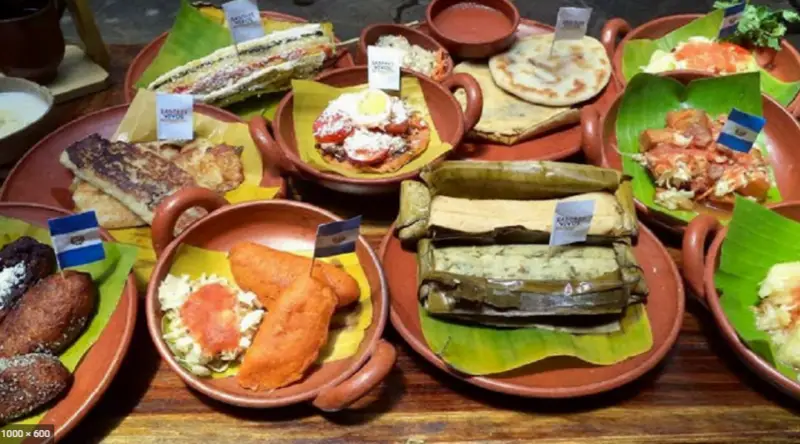Take Me to the Recipes
Imagine a land where towering volcanoes pierce the sky, casting shadows on vibrant coral reefs teeming with life. Picture lush rainforests teeming with exotic fruits, nestled beside fertile valleys bursting with sun-kissed coffee beans. This isn’t just a dream; it’s El Salvador, a Central American gem where history, geography, and food intertwine in a dance of delicious complexity.
But El Salvador’s story isn’t just about stunning landscapes. It’s about ancient Mayan whispers echoing in the wind, colonial influences adding a touch of spice, and the resilient spirit of a people who have woven their rich past into every bite.
Join us on a culinary adventure through El Salvador, where we’ll unravel the secrets hidden within its pupusas, the national dish stuffed with stories of tradition. We’ll explore how volcanic soil infuses coffee beans with fiery notes and how sun-kissed mangoes dance with the tang of fresh seafood.
Get ready to tantalize your taste buds and intrigue your mind as we discover how El Salvador’s unique history, geography, and culture have created a cuisine that’s as vibrant and diverse as the land itself. So, fasten your seatbelt, grab your virtual fork, and let’s embark on a journey to where flavors ignite your soul – El Salvador!
Take Me to the Recipes
Key Takeaways
- El Salvador cuisine is a fusion of traditional Salvadoran dishes and wider Latin American influences.
- The cuisine features a range of unique ingredients, including yuca, plantains, and red beans.
- Savor the authentic Central American flavors of El Salvador cuisine by trying the country’s most iconic dishes, like pupusas.
- El Salvador cuisine offers a unique cultural experience through its delicious and aromatic creations.
- Embark on a virtual culinary journey through El Salvador and experience the diverse flavors and textures of Salvadoran cuisine.
Where is El Salvador?

El Salvador is located in Central America, between Guatemala, Honduras, and the North Pacific Ocean.
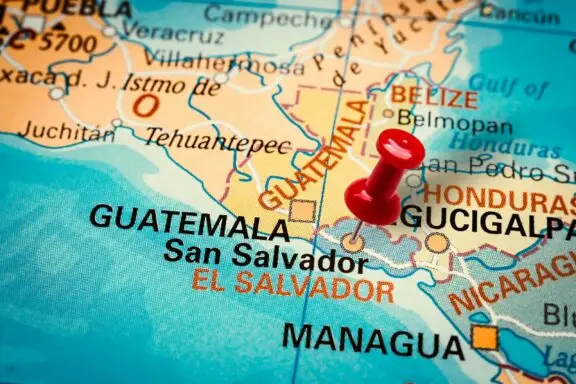
Index of the Contents
- Take Me to the Recipes
- More Articles
- 10 Interesting Facts about el Salvador
- El Salvadorian History and the Effect It Has Had on the Cuisine
- How the el Salvadorian Climate and Geography has Influenced the Cuisine
- Understanding the Essence of El Salvadorian Cuisine
- What is the National Dish of El Salvador?
- Exploring ’s Ingredients: The Flavors of El Salvadorian Cuisine
- Traditional El Salvador Cuisine
- The Street Food Scene in El Salvador
- Traditional Methods and Influences in El Salvadorian Cuisine
- 10 Popular El Salvadorian Recipes
- How Healthy is el Salvadorian Cuisine?
- El Salvadorian Recipes you can try in your own Kitchen
- Conclusion
- FAQ’s
You may also be interested in the following articles
- North and South American Cuisine – A Culinary Expedition
- Europe Cuisine: Savor the Continent’s Best Culinary Secrets!
- African Cuisine: Discover the Bold Flavors & Global Charm!
- Asian Cuisine Unlock its Secrets – Taste, Health & Global Influence!
Savor iconic El Salvador Food Recipes – Click on each tantalizing picture to open up the Recipe.
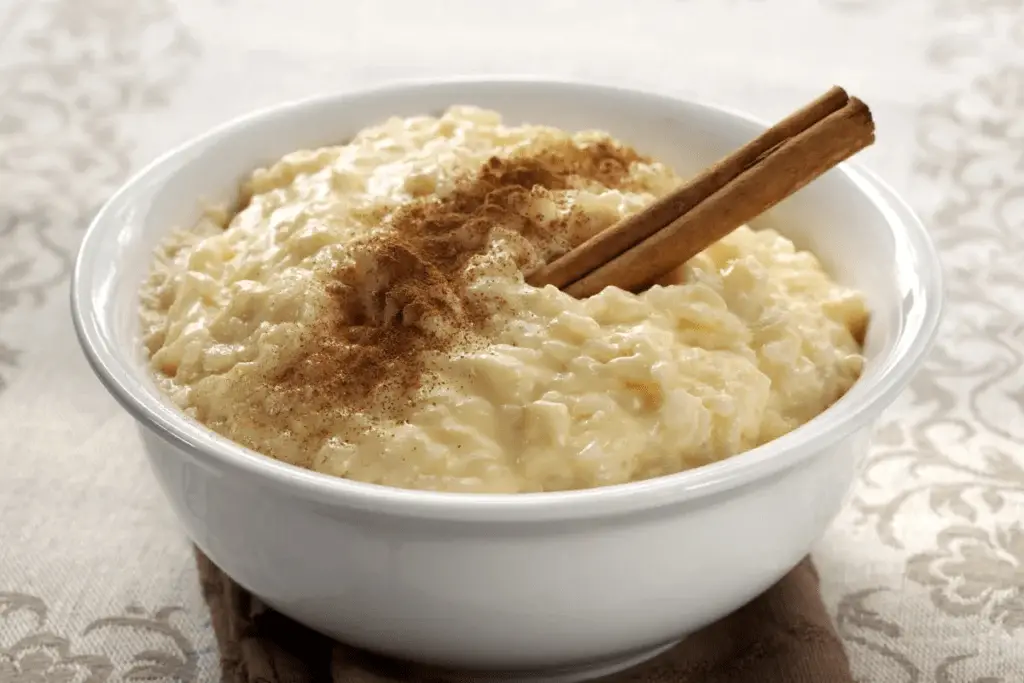
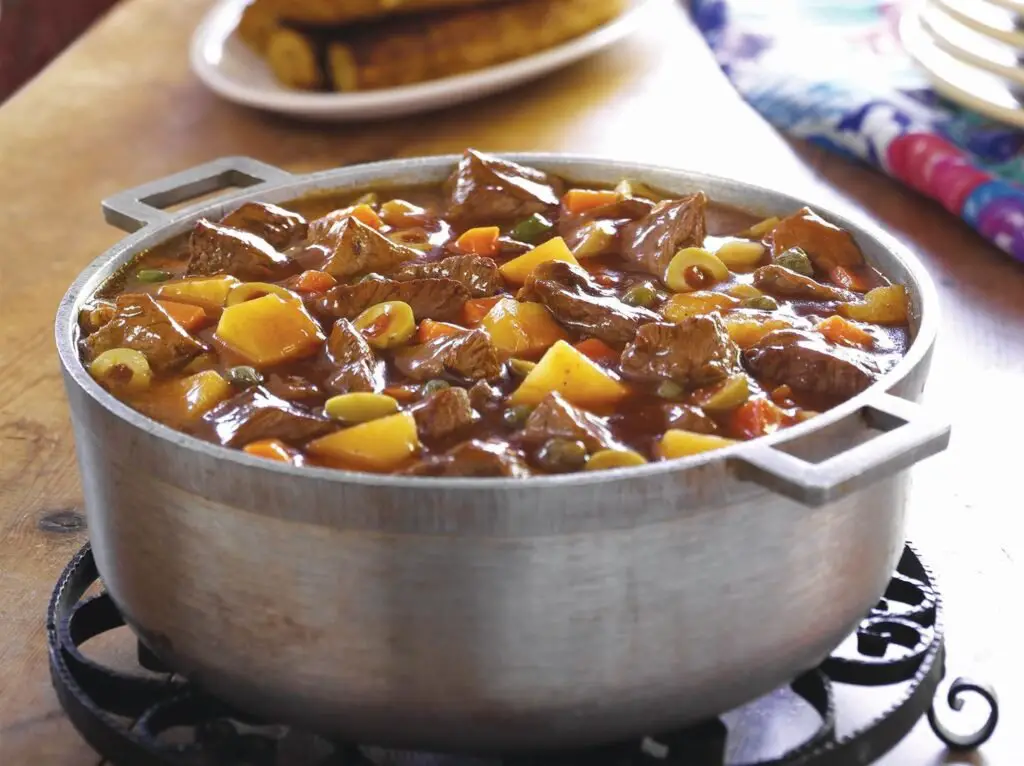
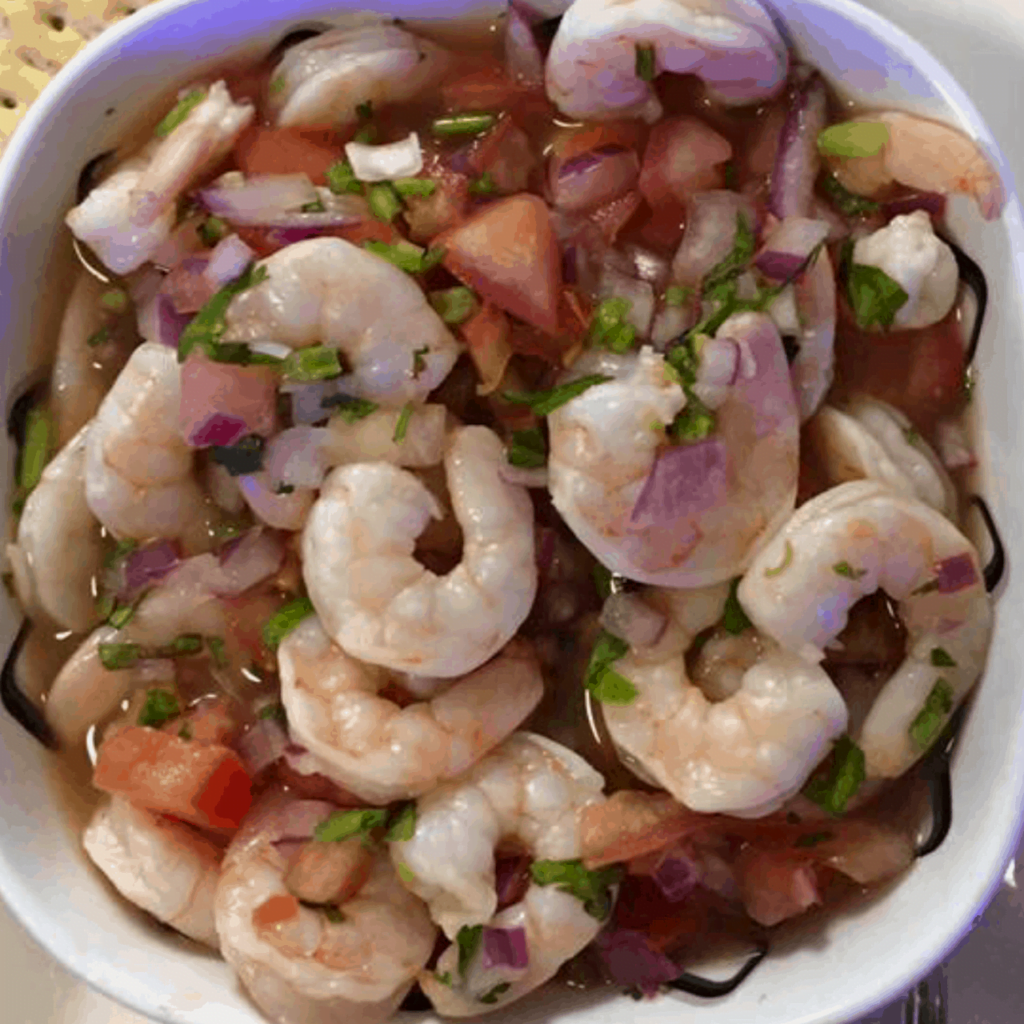
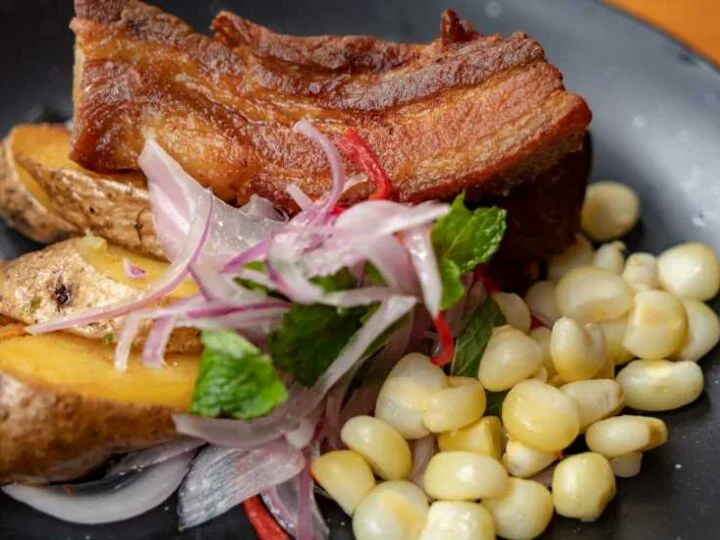

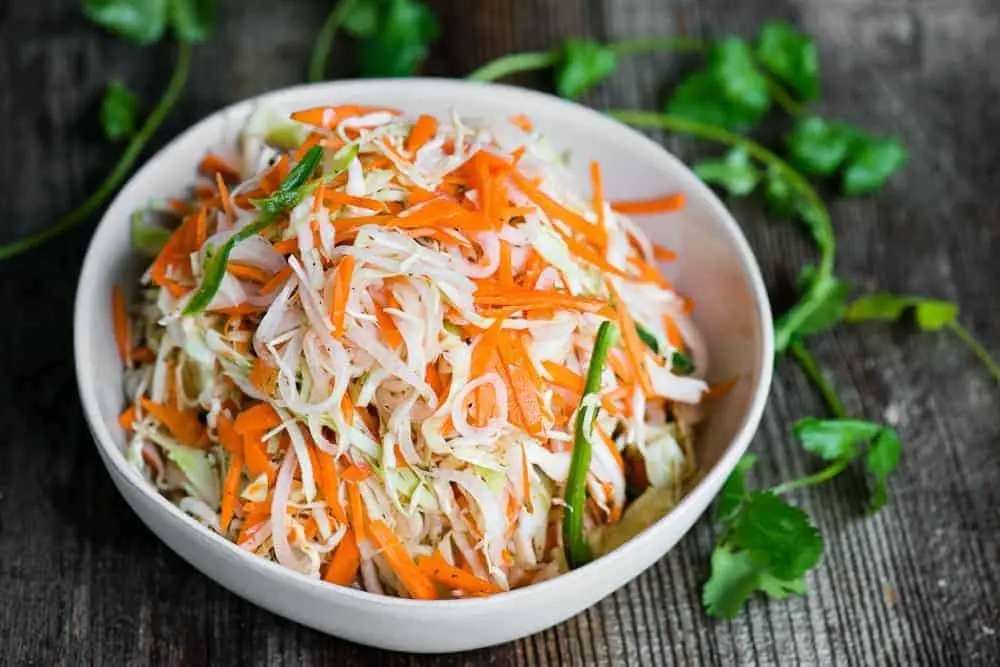
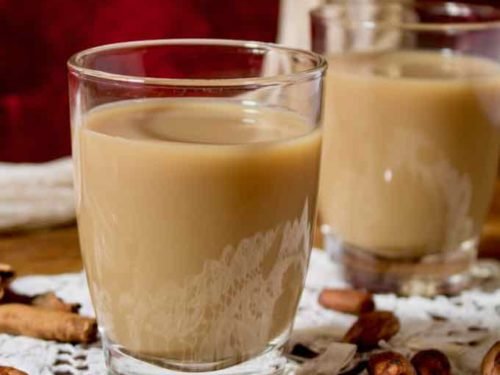
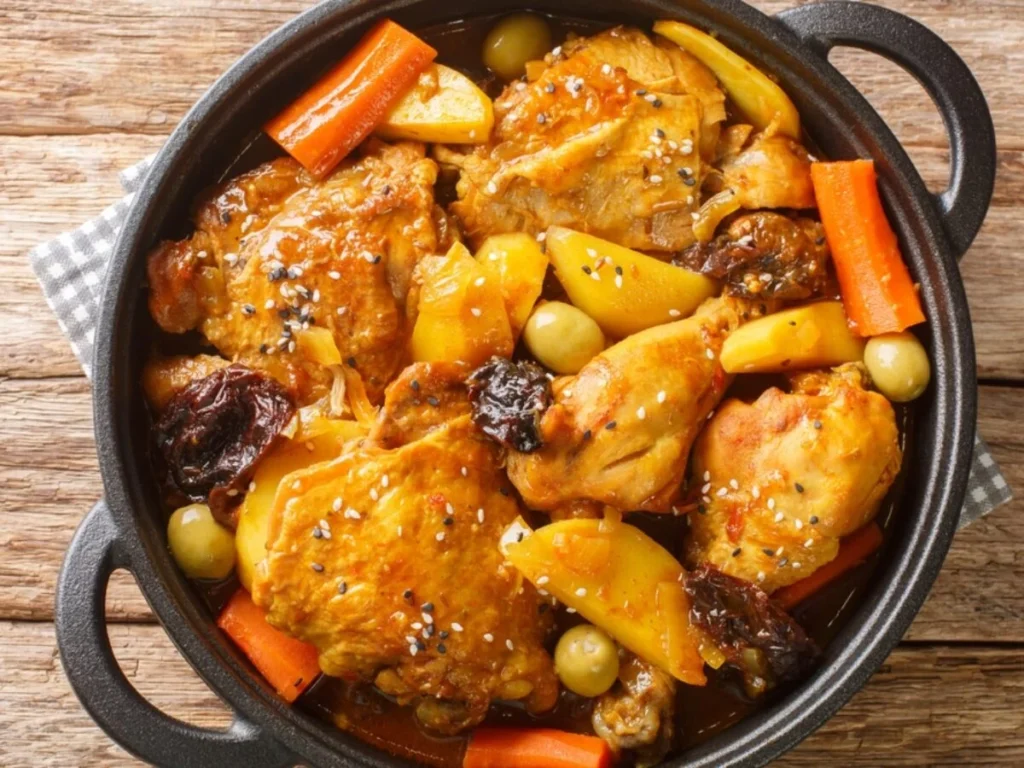
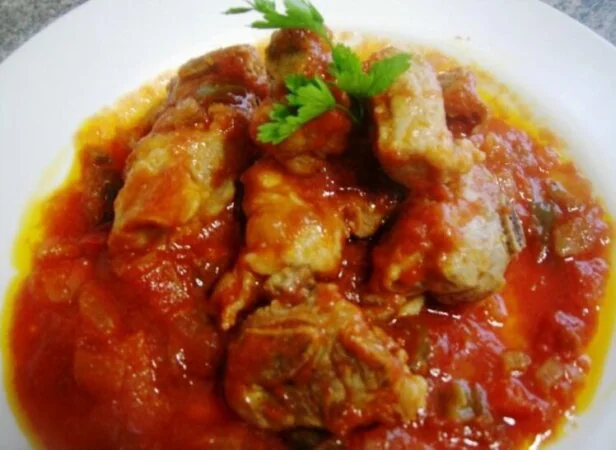
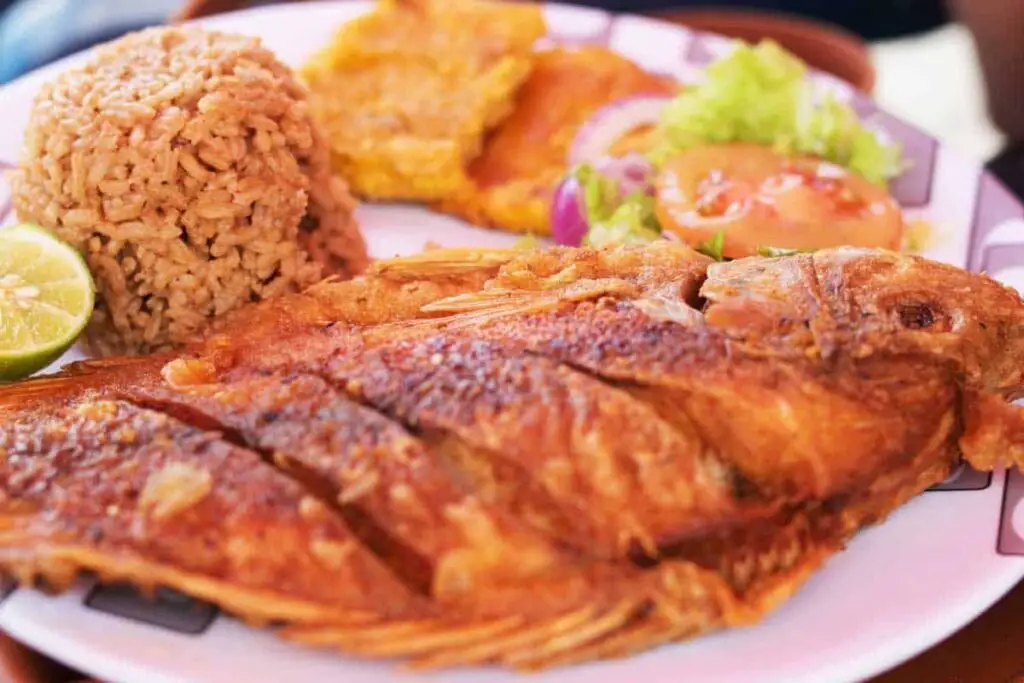
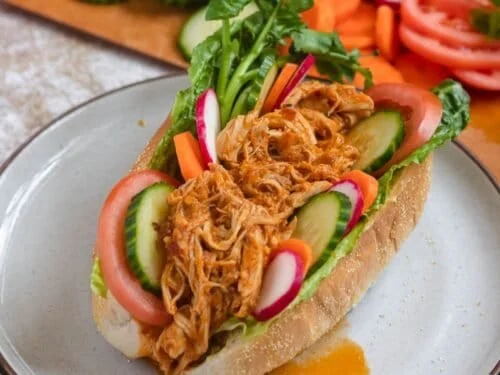
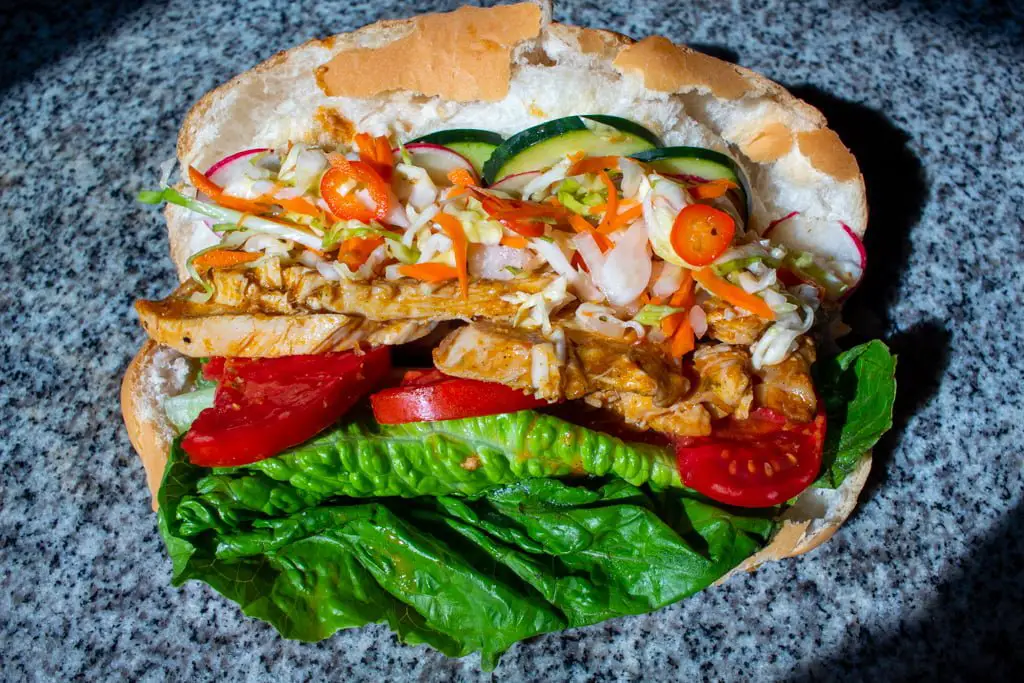
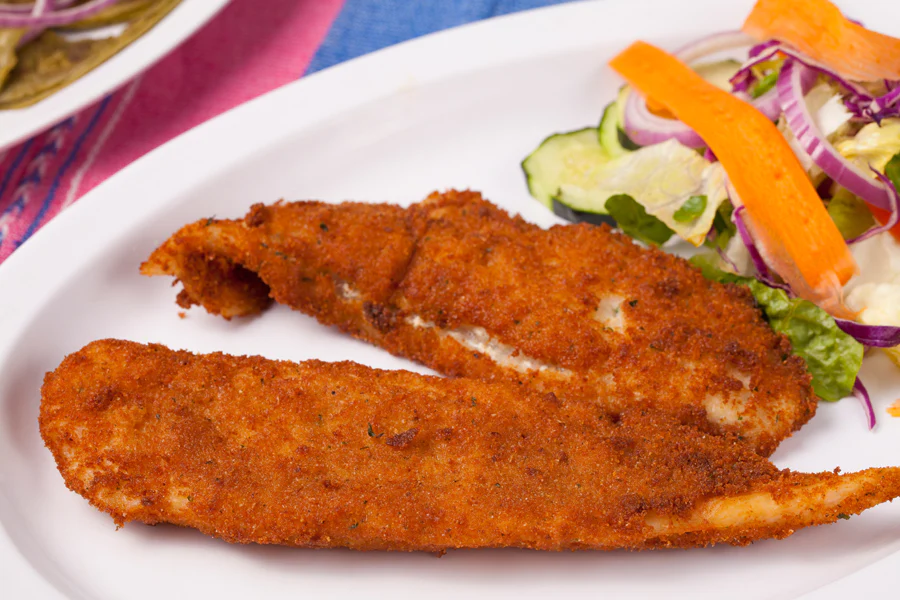
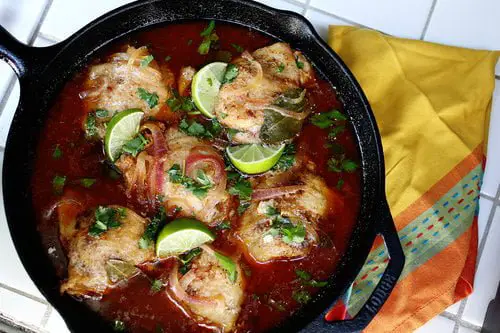
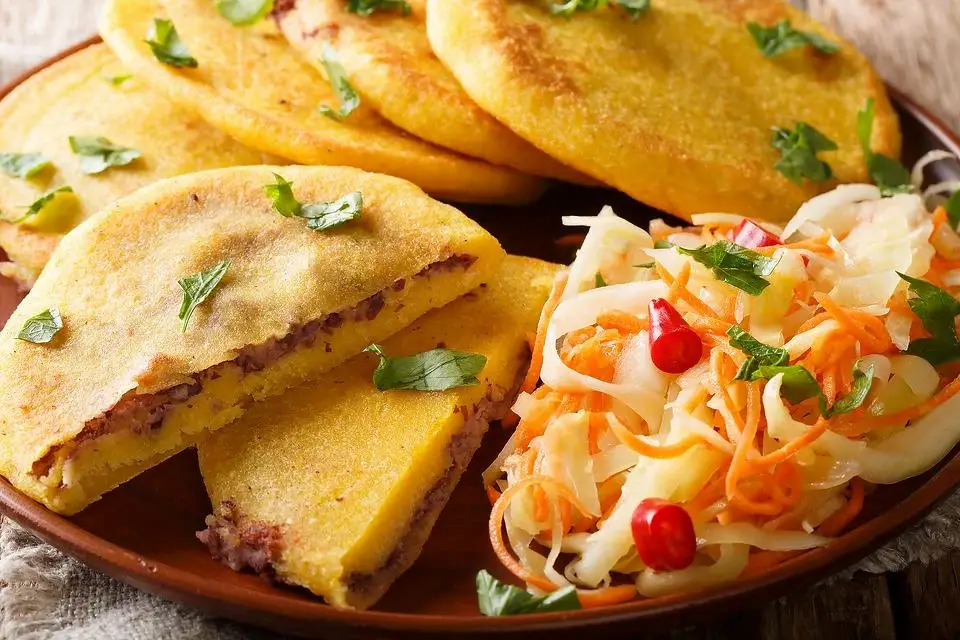
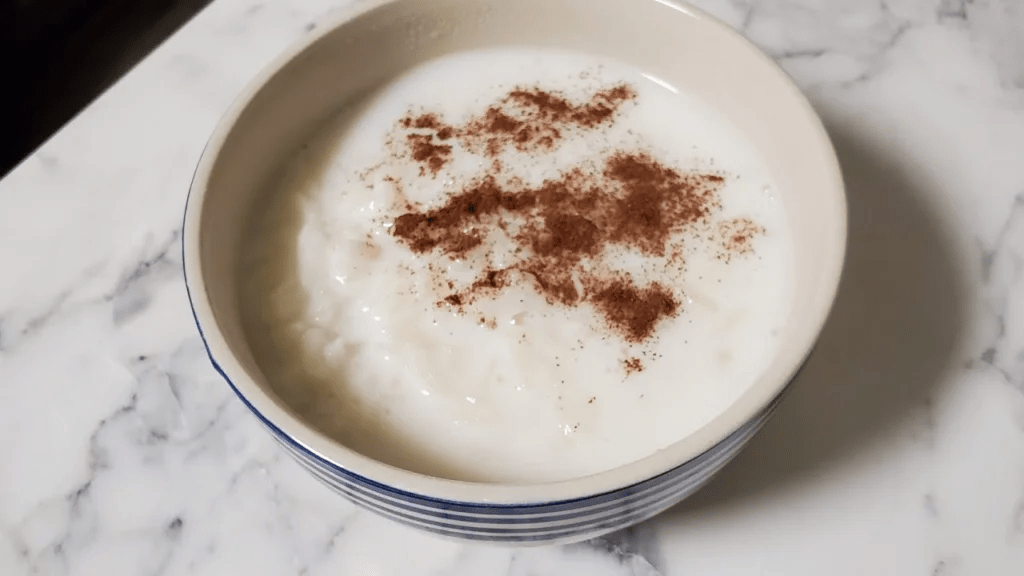
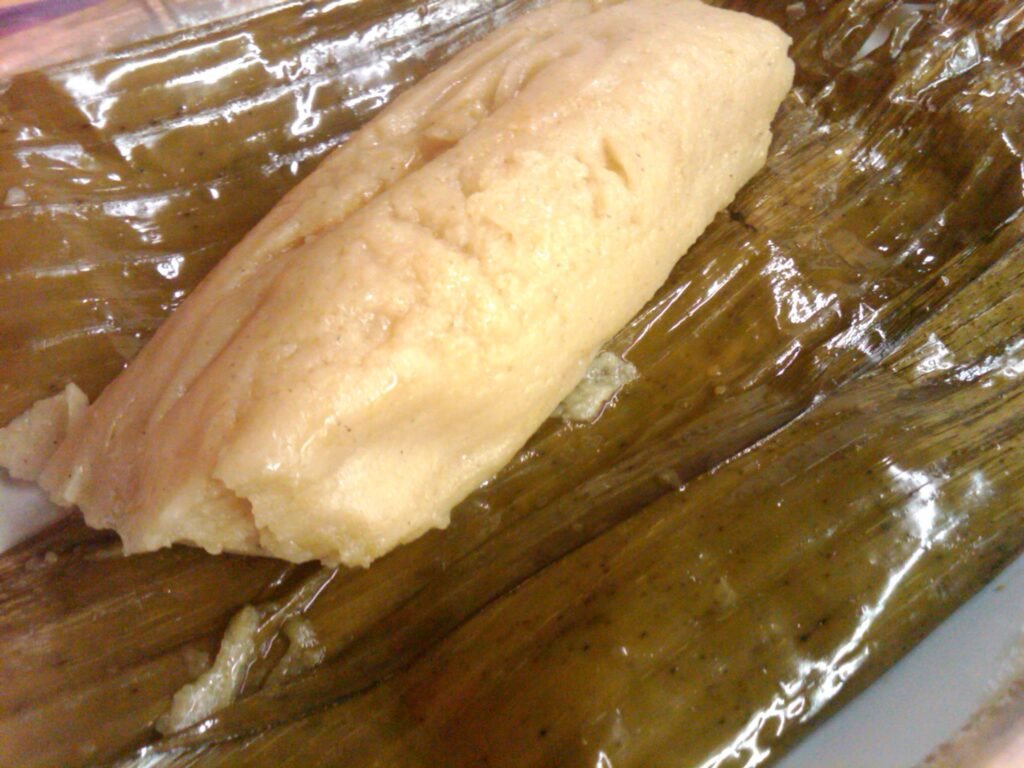
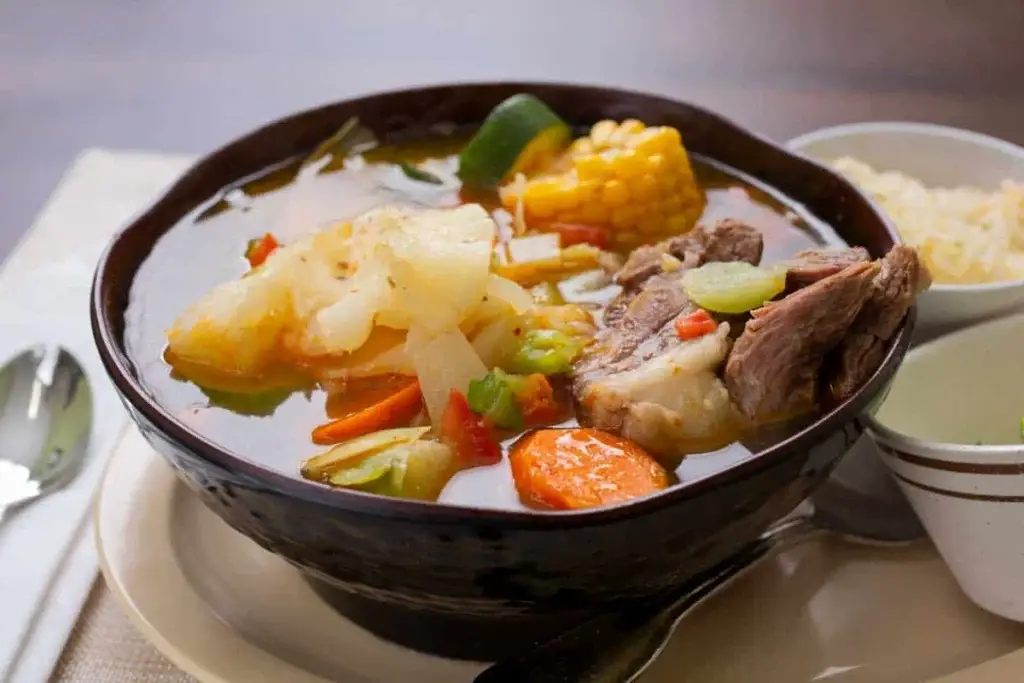
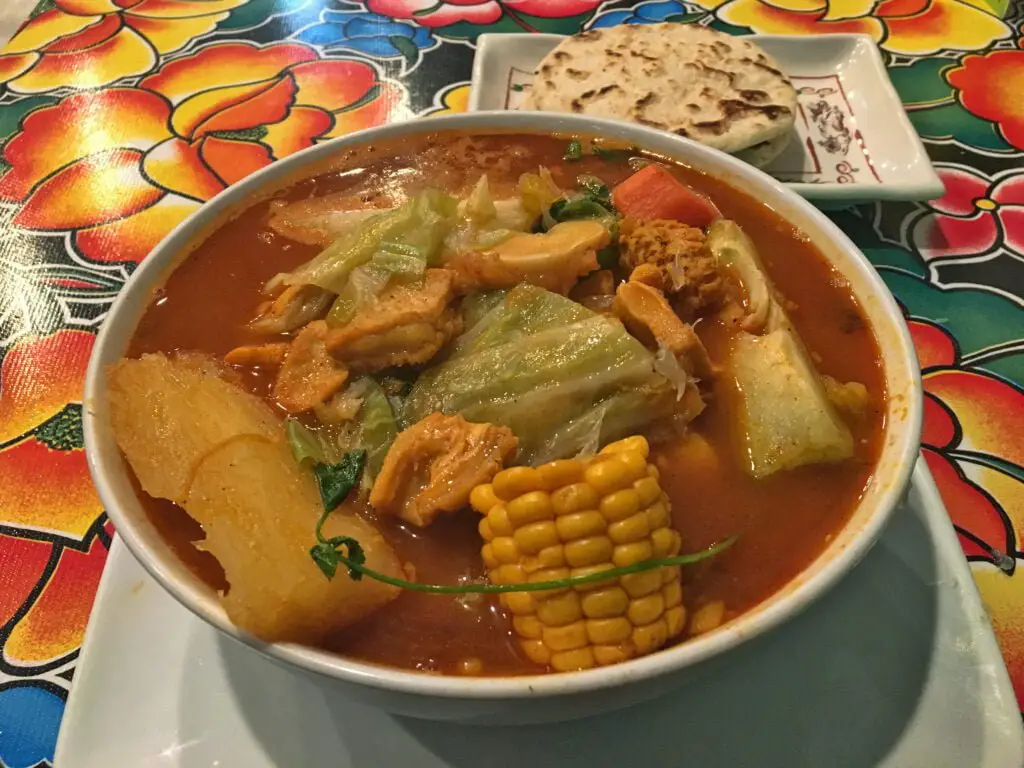
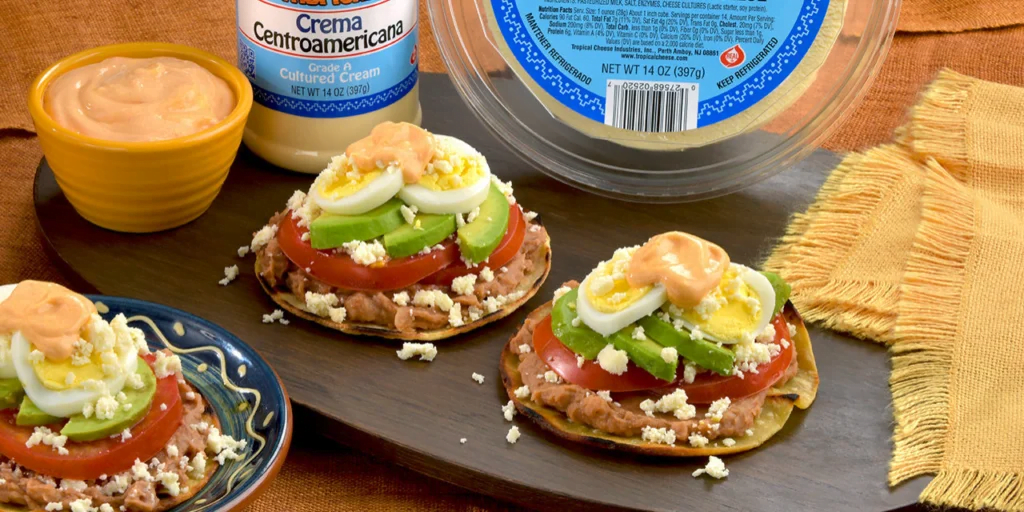
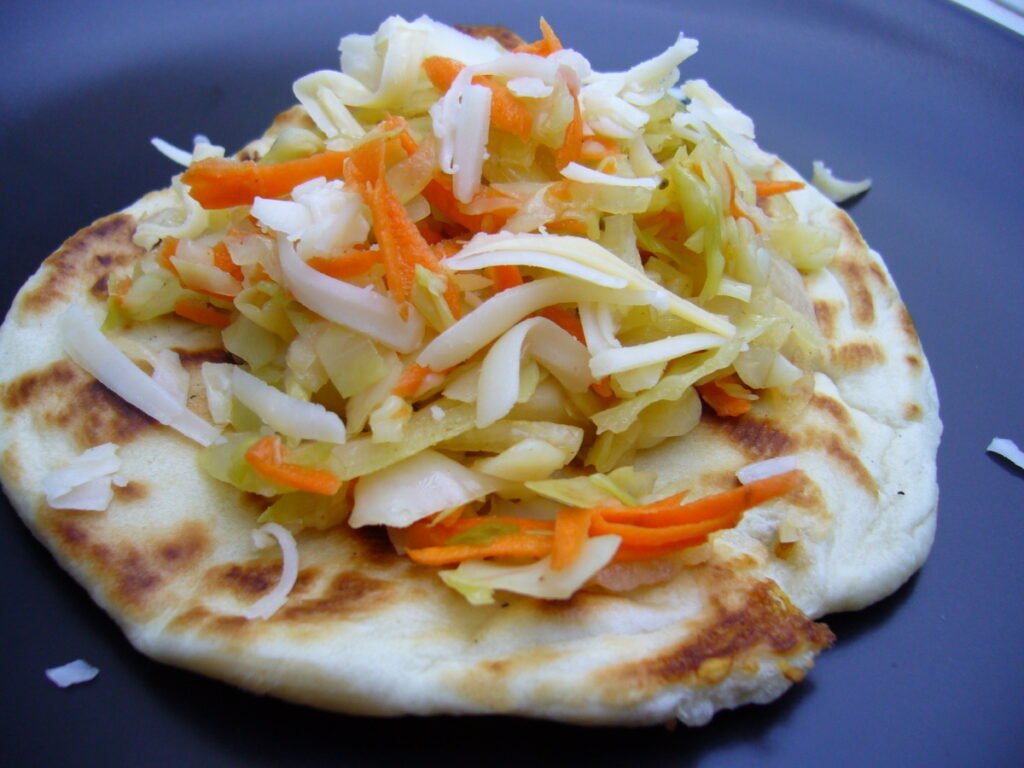
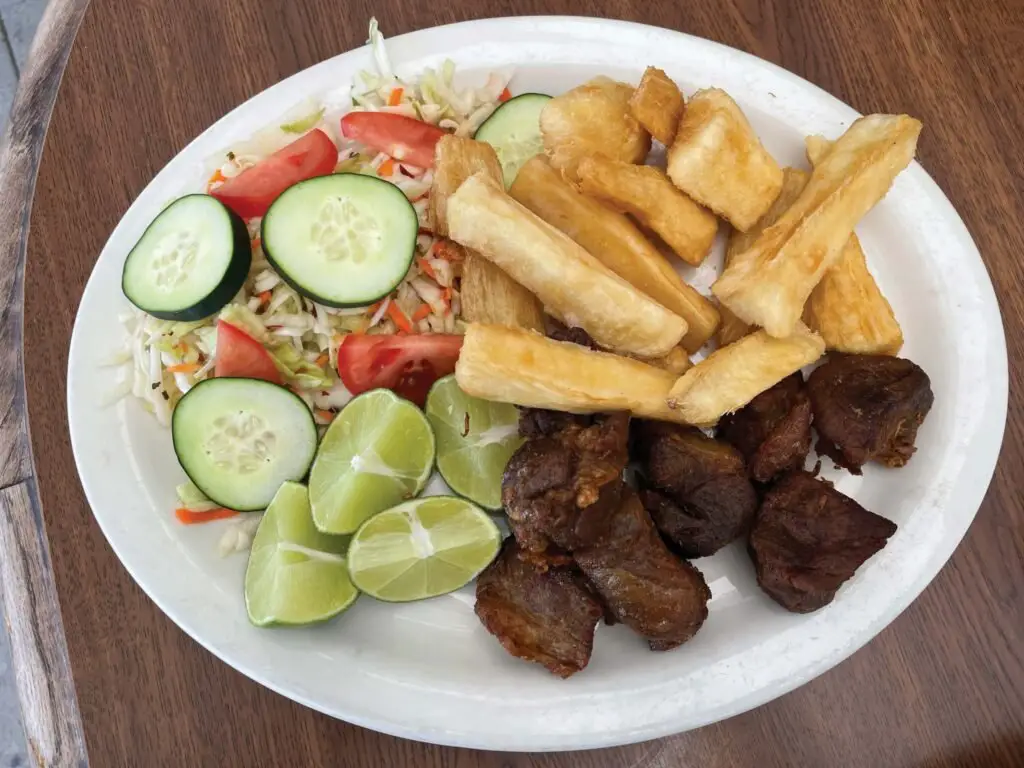
10 Interesting Facts about el Salvador

El Salvador, nestled in Central America, boasts vibrant beaches, lush rainforests, and a culture bubbling with fascinating quirks. Beyond the postcard-perfect scenery, intriguing stories simmer beneath the surface.
Buckle up, because we’re diving into 10 bizarre, funny, and thought-provoking facts about El Salvador that will leave you wanting more:
Pupusas with a Past
Forget boring tortillas! El Salvador’s national dish, the pupusa, may predate written history. Evidence suggests these stuffed delights were enjoyed by the Maya people as far back as 1400 years ago. Talk about a timeless tradition!
Surfing Santas Take Over

Forget reindeer and snow, imagine Santas shredding waves! Every December, El Salvador hosts the Surf City Surf Games, where Santas in wetsuits trade presents for surfboards, creating a spectacle you won’t see anywhere else.
A Coffee Capital with a Caveat
Salvadoran coffee is world-renowned for its rich flavor, but here’s a twist: the volcanic soil it grows in may contain traces of arsenic. Don’t worry, it’s well within safe limits, but adds a unique “geological kick” to your morning brew.
Coconuts with Faces

Ever seen a coconut with a face carved into it? In El Salvador, it’s a common sight! These “coquitos con carita” (coconuts with faces) are decorated and sold as souvenirs, reminding everyone to smile, even if you’re just a nut.
The Land of Hammocks
Forget rocking chairs, in El Salvador, hamacas (hammocks) are king. From relaxing on porches to enjoying family time, these woven wonders are a way of life, offering a laid-back approach to everyday activities.
A Colorful Cemetery Tradition

Unlike somber graveyards elsewhere, El Salvador’s cemeteries burst with color. El Día de los Difuntos (Day of the Dead) sees families painting tombs vibrant hues and decorating them with flowers, creating a festive atmosphere to honor their loved ones.
Thumbs Up or Thumbs Down? Think Twice
Unlike many cultures, a thumbs-up in El Salvador can be considered offensive. It’s best to stick to a friendly wave or nod to avoid any misunderstandings.
A Land of Volcanoes (Literally)

El Salvador is home to 20 volcanoes, some still active! While they pose a risk, they also contribute to the country’s fertile soil and stunning landscapes, making it a land of both beauty and potential danger.
The Bitcoin Beach Experiment
El Zonte, a beach town in El Salvador, became the world’s first Bitcoin Beach in 2021, aiming to boost tourism and financial inclusion. Whether it’s a revolutionary step or a risky gamble, only time will tell.
A Tiny Country with a Big Heart
Despite its small size, El Salvador boasts a rich cultural heritage, diverse ecosystems, and resilient people. From delicious pupusas to unique traditions, this hidden gem offers an unforgettable experience for those willing to explore.
So, there you have it! 10 Salvadoran secrets that will tickle your curiosity and leave you wanting to delve deeper into this captivating country. Remember, the most interesting discoveries often lie beyond the surface, waiting to be explored with an open mind and a sense of adventure.
El Salvadorian History and the Effect It Has Had on the Cuisine

El Salvador, a vibrant tapestry of ancient Mayan legacy and Spanish colonial heritage, boasts a cuisine as rich and layered as its history. Let’s embark on a mouthwatering journey, exploring how each era has added its unique spices to the Salvadoran table:
Indigenous Roots: Where it All Began (Pre-Columbian Era)
Long before Spanish conquistadors set foot on Salvadoran soil, indigenous groups like the Pipil, Lenca, and Maya nurtured a thriving culinary scene. Maize (corn), still the heart of Salvadoran cuisine, held a central place in their diet.
Even ancient ruins like Tazumal and Joya de Cerén whisper stories of pre-Columbian culinary practices, waiting to be unearthed.
A Fusion of Flavors: The Spanish Embrace (16th Century Onwards)

The arrival of the Spanish Empire in the 16th century marked a new chapter. European ingredients like chickpeas, onions, and pork joined the indigenous pantry, leading to exciting culinary fusions. This era witnessed the birth of the iconic pupusa, a thick, handmade corn or rice flour tortilla stuffed with savory delights like cheese, chicharrón (ground pork), refried beans, or the unique loroco flower bud.
Other beloved dishes like pollo encebollado (chicken simmered in onions) and yuca frita (deep-fried cassava root) showcase the enduring influence of Spanish flavors.
Modern Twists on Tradition (19th Century to Present)

As El Salvador’s economy transitioned from coffee exports to a service-oriented landscape, its cuisine continued to evolve. Traditional dishes like carne guisada (beef stew), lomito entomatado (beef in tomato sauce), and panes rellenos (stuffed sandwiches) reflect this shift, offering hearty options for busy lifestyles.
Seafood lovers rejoice with ceviche de camarones (lime-cooked shrimp) and pescado empanizado (crispy fried fish fillets). And don’t forget the essential Salvadoran cheeses, like queso duro and fresco, adding their creamy goodness to countless dishes.
A Legacy of Ingredients: A Taste of El Salvador’s Heart
Beyond delicious dishes, specific ingredients whisper stories of cultural heritage:
- Pupusa: This Mesoamerican treasure, dating back to the ancient Maya, holds a special place in the Salvadoran heart. Each bite connects the present to a rich indigenous past.
- Yuca: Enjoyed fried, boiled, or topped with curtido (pickled cabbage), this versatile root vegetable is a staple across generations.
- Loroco: This unique native flower bud adds a touch of the unexpected to pupusas, reminding us of El Salvador’s unique culinary identity.
A Celebration of Identity: Food that Binds
Salvadoran cuisine is more than just a collection of dishes; it’s a vibrant tapestry woven from indigenous ingenuity, Spanish influences, and modern adaptations. The pupusa, a symbol of national pride, stands as a testament to this harmonious blend.
So, the next time you savor a Salvadoran dish, remember you’re not just indulging your taste buds; you’re experiencing a cultural journey through time, one delicious bite at a time.
References:
- History of El Salvador – Encyclopedia Britannica
- Salvadoran cuisine – Wikipedia
- The Story of Salvadoran Food by Alicia Maher
- Timeline of the History of El Salvador — The World in a Pocket
How the El Salvadorian Climate and Geography has Influenced the Cuisine
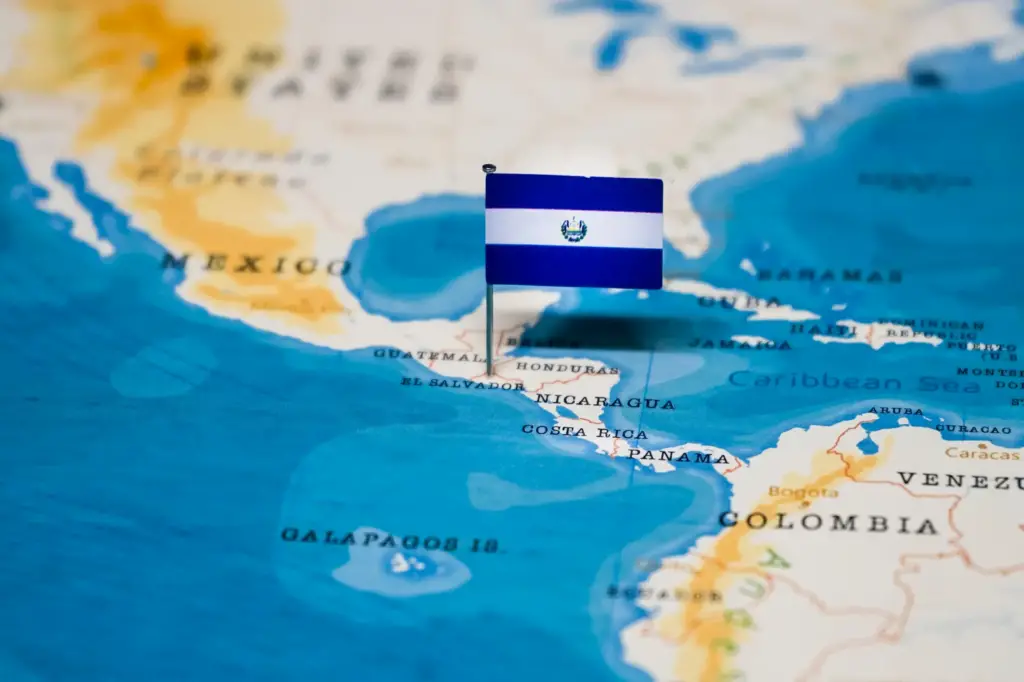
El Salvador, a vibrant tapestry of soaring mountains, fertile valleys, and a sparkling Pacific coastline, boasts a cuisine as diverse and delicious as its landscape. But this culinary richness isn’t simply a matter of chance; it’s intricately woven from the threads of climate, geography, and history. Let’s delve into how these factors have shaped the unique flavors of El Salvador:
A Symphony of Seasons
El Salvador experiences a tropical climate with distinct wet and dry seasons. This climatic dance plays a central role in its cuisine:
- The Reign of Maize: During the rainy season, maize (corn) thrives, its abundance reflected in its central role in Salvadoran dishes. From tortillas to the iconic pupusas (stuffed tortillas), corn forms the base of countless meals, a legacy inherited from indigenous groups like the Lenca, Pipil, and Maya.
- Tropical Treats: The hot Pacific lowlands sing with the bounty of the sea. Fresh seafood takes center stage in dishes like ceviche (marinated raw fish) and pescado empanizado (crispy fried fish fillets), reflecting the region’s easy access to the ocean’s bounty.
- Mountain Magic: Cooler mountain regions favor heartier stews like pollo encebollado (chicken simmered with onions). This adaptation to temperature variations demonstrates how Salvadoran cuisine has mastered the art of utilizing local ingredients effectively.

A Fusion Feast: Traces of History on the Plate
El Salvador’s cuisine also bears the imprint of its historical journey:
- European Embrace: The arrival of the Spanish in the 16th century introduced pork and cheese, now essential ingredients in dishes like pupusas. This fusion of indigenous and European influences exemplifies the cultural exchange that shaped the nation’s identity.
- Yuca: An Enduring Staple: Another legacy of indigenous ingenuity is yuca (cassava root). Eaten fried or boiled, it finds its way into various dishes, often paired with the tangy curtido (pickled cabbage), showcasing the resourcefulness of early inhabitants.
Modern Twists on Tradition
While respecting its traditions, Salvadoran cuisine embraces modern adaptations:
- Panes Rellenos: These hearty submarine sandwiches filled with roasted turkey or chicken offer a convenient and delicious option for busy lifestyles, reflecting the changing pace of life.
- Global Influences: International influences peek through in dishes like pastelitos (fried pastries) and salpicón (a cold meat salad), demonstrating El Salvador’s openness to the world without losing its culinary identity.
References
- Food and Agriculture Organization of the United Nations. (2000). The Salvadoran Food Consumption and Anthropometric Surveys 2000
- Pan American Health Organization. (2021). Health in the Americas Plus 2021: El Salvador
- World Health Organization. (2023). Global Health Observatory data repository: El Salvador.
- worldfacts.us
- en.wikipedia.org
Understanding the Essence of El Salvadorian Cuisine

El Salvador’s cuisine isn’t just food; it’s a vibrant tapestry woven from sun-kissed ingredients, diverse influences, and a vibrant history. Unlike a single note, it’s a harmonious orchestra of flavors, each reflecting the unique essence of this Central American nation. So, what makes it truly stand out?
A Land of Plenty, a Symphony of Ingredients
El Salvador’s tropical climate and varied terrain offer a bounty of ingredients, forming the foundation of its cuisine:
- Maize (Corn): The undisputed king, corn reigns supreme, echoing its importance in indigenous cultures. From tortillas to pupusas, its versatility shines through.
- The Sea’s Bounty: The Pacific Ocean offers an abundance of fresh seafood, evident in dishes like ceviche and pescado empanizado, bringing a refreshing touch to the table.
- Land’s Bounty: Lush valleys yield fruits and vegetables, while fertile mountains nurture heartier fare like plantains and yuca, showcasing the land’s diverse flavors.
A Fusion Fiesta: History on a Plate
El Salvador’s cuisine bears the delicious imprint of its historical journey:
- Indigenous Echoes: Dishes like pupusas and the use of yuca whisper stories of the Lenca, Pipil, and Maya people, reminding us of the land’s ancient culinary heritage.
- Spanish Embrace: The arrival of the Spanish in the 16th century introduced pork, cheese, and spices, enriching the culinary landscape. Pupusas stuffed with chicharrón (ground pork) are a testament to this fusion.
Beyond Borders, Yet Rooted in Tradition
Modernity adds its own flavors, but tradition remains:
- Global Influences: International influences peek through in pastelitos (fried pastries) and salpicón (cold meat salad), demonstrating openness to the world while maintaining a distinct identity.
- Hearty Staples: Panes rellenos (submarine sandwiches) offer a convenient option for busy lifestyles, adapting to a changing pace of life.
The Essence: More Than Just Flavor
What truly makes El Salvadorian cuisine unique? It’s:
- Freshness: Local, seasonal ingredients shine, offering a burst of vibrant flavors in every bite.
- Balance: Savory and sweet, spicy and refreshing, textures collide in perfect harmony, keeping your palate engaged.
- Soulful Comfort: Simple, hearty dishes like frijoles refritos (refried beans) and plantains evoke a sense of home and cultural pride.
- A Story in Every Bite: Each dish whispers tales of past and present, connecting you to the land, people, and history.
What is the National Dish of El Salvador?

The national dish of El Salvador is the Pupusa, a thick, handmade flatbread traditionally made with either corn or rice flour. It’s typically stuffed with savory fillings like cheese, refried beans, chicharrón (ground pork), or loroco (a native vine flower bud). These delicious pockets of flavor are cooked on a griddle and often served with curtido (pickled cabbage, onion, and carrot), adding a tangy counterpoint.
Pupusas hold a special place in Salvadoran hearts, transcending their status as mere food. They are:
- A Symbol of Identity: Representing the nation’s indigenous heritage and culinary ingenuity, pupusas connect Salvadorans to their roots and cultural pride.
- A Culinary Ambassador: Showcasing the diverse flavors and influences that shape El Salvador, pupusas have become a beloved dish enjoyed worldwide.
- A Community Staple: From street vendors to family gatherings, pupusas bring people together, fostering a sense of shared experience and tradition.
Exploring El Salvador’s Ingredients: The Flavors of el Salvadorian Cuisine

El Salvador’s vibrant cuisine isn’t just about delicious dishes; it’s a fascinating journey through the country’s rich history, diverse geography, and skilled culinary traditions. Each ingredient whispers a story, reflecting the influences of indigenous ingenuity, European encounters, and modern adaptations.
Maize (Corn): The Undisputed King
Corn stands tall as the unquestionable king of Salvadoran cuisine. Its legacy stretches back to ancient indigenous cultures, forming the base of countless dishes: tortillas, pupusas, atol (a warm, thick beverage), and more.
Its versatility and cultural significance are undeniable, a testament to its historical importance.
The Sea’s Bounty
El Salvador’s Pacific coastline generously provides an abundance of fresh seafood. Dishes like ceviche (marinated raw fish), pescado empanizado (crispy fried fish fillets), and shrimp cocktails showcase the ocean’s influence.
These ingredients bring a refreshing and flavorful touch to the menu, reflecting the importance of the maritime landscape.
Yuca: A Timeless Staple
Yuca, also known as cassava root, is another indigenous legacy deeply ingrained in Salvadoran cuisine. Eaten fried, boiled, or mashed, it adds a distinct starchy texture and earthy flavor to various dishes.
Yuca frita (fried yuca) is a popular side dish, while boiled yuca often replaces bread in some regions, highlighting its adaptability and enduring presence.
Loroco: A Taste of the Land
This unique edible flower bud native to Central America adds a delightful floral twist to El Salvador’s culinary scene. Most notably found in pupusas, loroco infuses a subtle perfume-like aroma and delicate flavor, contributing to the dish’s complexity and cultural identity.
Pupusas: More Than Just Food
These iconic thick, stuffed tortillas deserve a special mention. Filled with a variety of savory combinations like cheese, chicharrón, beans, and loroco, pupusas are not just a dish; they’re a symbol of national pride and cultural heritage.
Their hand-crafted nature, diverse fillings, and connection to indigenous ancestry make them a must-try for any culinary adventure in El Salvador.
Modern Twists on Tradition
While respecting its heritage, Salvadoran cuisine embraces modern adaptations. Panes rellenos, filled with roasted turkey or chicken, offer a convenient and delicious option for busy lifestyles.
International influences peek through in pastelitos (fried pastries) and salpicón (cold meat salad), demonstrating an openness to the world while maintaining a distinct identity.
Traditional El Salvador Cuisine
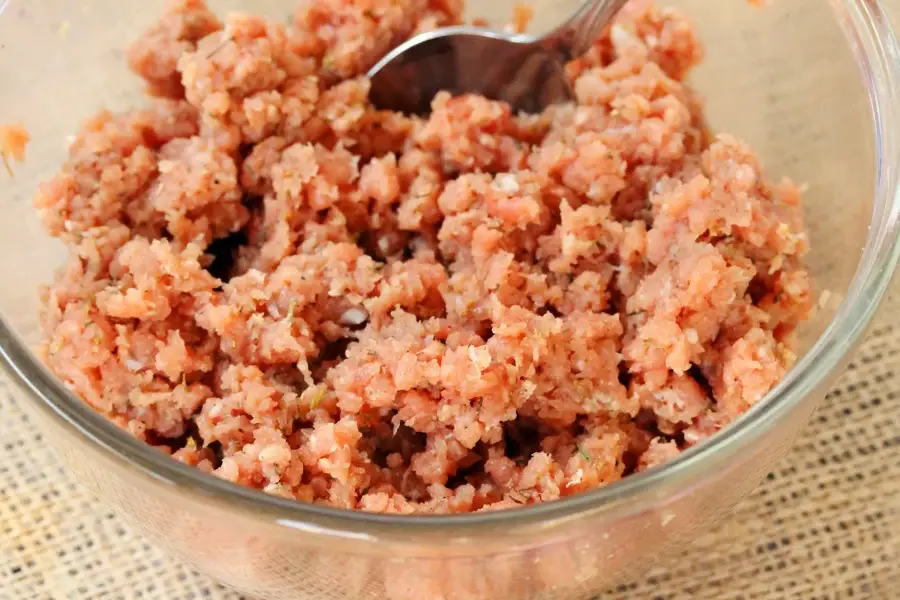
El Salvador’s cuisine boasts a deep well of tradition, drawing upon Indigenous ingenuity, Spanish influences, and modern adaptations. Each bite whispers stories of cultural exchange, resourcefulness, and a deep connection to the land.
Let’s delve into some of the most iconic dishes and ingredients that define this vibrant culinary landscape:
The Crown Jewel: Pupusas
Arguably the most revered dish, pupusas are thick, handmade tortillas stuffed with savory delights. Traditionally made from corn or rice flour, these pockets of flavor explode with fillings like cheese, refried beans, chicharrón (ground pork), or loroco (a native flower bud).
They are typically cooked on a griddle and served with curtido (pickled cabbage, onion, and carrot) for a tangy counterpoint. Pupusas transcend mere food; they represent national pride, cultural heritage, and community bonding, often enjoyed at family gatherings and street vendors alike.
Staples with a Story
Maize (corn) reigns supreme, its versatility showcased in tortillas, atol (a warm, thick beverage), and countless other dishes. Yuca (cassava root), another indigenous staple, offers a starchy texture and earthy flavor, enjoyed fried, boiled, or mashed.
Yuca frita (fried yuca) is a beloved side dish, while plantains provide sweetness and sustenance. These ingredients whisper tales of generations past, highlighting the resourcefulness and resilience of the Salvadoran people.
A Taste of the Sea
El Salvador’s Pacific coast generously shares its bounty. Fresh seafood plays a starring role in ceviche (marinated raw fish), pescado empanizado (crispy fried fish fillets), and shrimp cocktails. These refreshing dishes showcase the importance of the maritime landscape and the local fishing traditions.
A Fusion Fiesta
The Spanish arrived in the 16th century, leaving their mark on ingredients like pork, cheese, and onions. Dishes like pollo encebollado (chicken simmered with onions) and panes rellenos (stuffed sandwiches) exemplify this fascinating culinary fusion.
European influences weave into the fabric of El Salvador cuisine, adding new layers of flavor and complexity.
Beyond the Plate
Traditional El Salvador cuisine extends beyond individual dishes. It’s about shared experiences, communal cooking, and celebrating local bounty.
Family recipes passed down through generations, vibrant markets bursting with fresh produce, and the festive atmosphere of street food vendors all contribute to this unique culinary culture.
The Street Food Scene in El Salvador
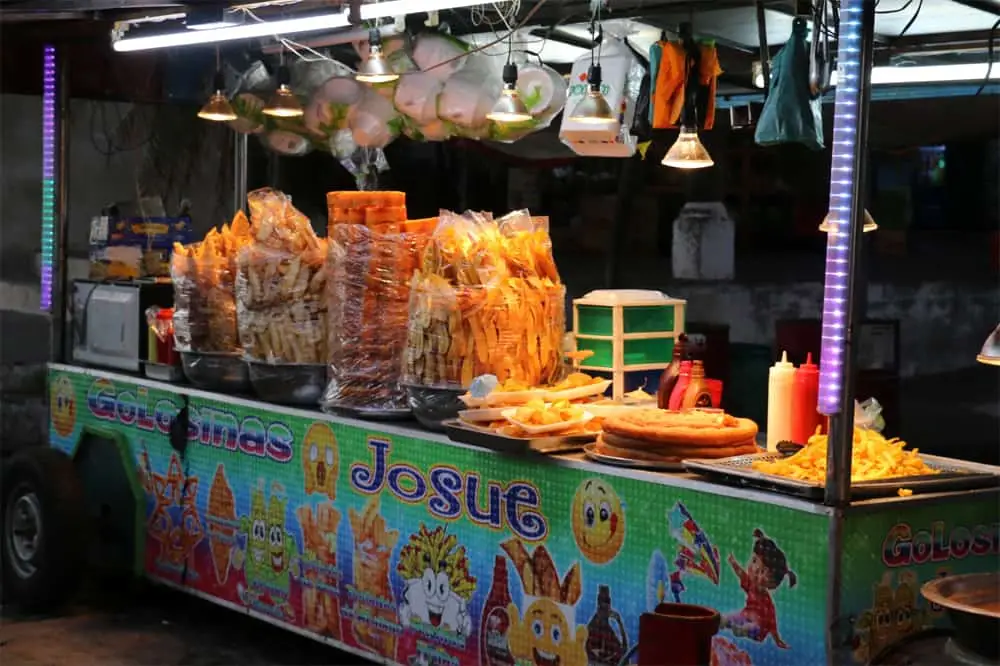
El Salvador, a small but culturally rich Central American country, boasts a street food scene that reflects the nation’s diverse culinary heritage. From savory pupusas to refreshing beverages, the streets of El Salvador are a culinary adventure waiting to be savored.
Pupusas: The Heart of Street Food
History and Background: Pupusas, a quintessential Salvadoran dish, are thick corn tortillas filled with a variety of ingredients such as cheese, beans, and loroco flowers. This street food staple traces its roots back to indigenous communities, evolving over centuries into the beloved national dish.
Varieties: El Salvador offers a myriad of pupusa variations, each bursting with unique flavors. Revueltas, filled with beans, cheese, and pork, are a popular choice. Queso con Loroco, featuring cheese and edible flowers, provides a taste of the country’s biodiversity.
Tamales: A Flavorful Tradition
Background: Tamales, wrapped bundles of seasoned meat and masa (corn dough), are another street food gem in El Salvador. With roots in Indigenous and Spanish culinary influences, Salvadoran tamales have become a cherished part of local celebrations and everyday life.
Types: Tamales in El Salvador come in various forms, such as Tamales de Pollo (chicken tamales) and Tamales de Elote (sweet corn tamales). Often served wrapped in banana leaves, these handheld delights showcase the country’s rich culinary tapestry.
Aguas Frescas: Refreshing Elixirs
Refreshing Beverages: No exploration of El Salvador’s street food scene is complete without sipping on Aguas Frescas. These cooling beverages, made from fresh fruits, seeds, and flowers, offer respite from the tropical heat. Horchata (made from rice and cinnamon) and Tamarindo (tamarind-based) are popular choices.
Pupuserías and Food Stalls: The Street Food Haven
Street Vendors: The streets of El Salvador come alive with the hustle and bustle of food vendors, especially around bustling markets and plazas.
Pupuserías, dedicated establishments specializing in pupusas, and colorful food stalls dot the urban landscape, inviting locals and visitors alike to savor the diverse flavors of Salvadoran street cuisine.
Cultural Experience: Exploring the street food scene in El Salvador is not just about satisfying hunger; it’s a cultural experience. Engaging with friendly vendors, witnessing the artistry of pupusa-making, and immersing oneself in the vibrant atmosphere create lasting memories.
Conclusion: A Culinary Adventure
In El Salvador, street food isn’t just about convenience; it’s a celebration of the country’s history, traditions, and the warm hospitality of its people.
Whether you’re strolling through the markets of San Salvador or venturing into local neighborhoods, the diverse and delicious street food offerings are sure to leave you with a taste of El Salvador’s culinary brilliance.
Traditional Methods and Influences in El Salvadorian Cuisine

El Salvadorian cuisine is a tapestry woven with centuries of tradition, shaped by indigenous roots, Spanish colonization, and modern influences. The preparation methods and flavor profiles reflect the country’s diverse history and the resourcefulness of its people in utilizing local ingredients. Let’s delve into the traditional methods and influences that make El Salvadorian cuisine a rich and unique culinary experience.
Indigenous Ingredients and Techniques
Maize as a Foundation: Corn, or maize, holds a sacred place in El Salvadorian cuisine. Indigenous communities have cultivated various varieties of corn, using it as a staple in the form of tortillas, tamales, and atole. Traditional nixtamalization, a process of soaking and cooking maize in an alkaline solution, is employed to make masa, the corn dough central to many dishes.
Pupusas: Handmade Artistry: Pupusas, a national treasure, showcase the artistry of El Salvadorian cuisine. Handmade from masa, pupusas are filled with beans, cheese, loroco flowers, or chicharrón (fried pork). The process of shaping and grilling pupusas has been passed down through generations, preserving the authenticity of this beloved dish.
Spanish Colonial Influences
Meat and Dairy from European Influence: Spanish colonization introduced new elements to El Salvadorian cuisine, particularly in the form of meats and dairy products. Today, dishes like carne asada (grilled meat) and quesadillas reflect the fusion of indigenous and Spanish culinary traditions.
Sopa de Pata: A Spanish Legacy: Sopa de Pata, a hearty soup made with cow’s trotters, vegetables, and spices, is a testament to the Spanish culinary influence. This dish, adapted and embraced by Salvadorians, showcases the melding of old-world flavors with local ingredients.
Influences from Global Trade and Migration
Pacaya Palm Flower: A Culinary Treasure: Introduced during the colonial period, pacaya palm flowers have become a distinctive element in El Salvadorian cuisine. The flower buds are harvested and prepared in various dishes, adding a unique texture and flavor. Pacaya is often featured in salads, stews, and tamales.
Global Flavors in Street Food: El Salvador’s street food scene is a vibrant melting pot of global influences. Dishes like yuca frita (fried yuca) and pupusas revueltas showcase the fusion of traditional techniques with modern tastes. Street vendors often incorporate international flavors, reflecting the influence of global trade and contemporary culinary trends.
Preserving Culinary Heritage
Family and Community Traditions: El Salvadorian cuisine is not merely a collection of recipes; it’s a living tradition passed down within families and communities. From the preparation of Salvadorian tamales during holidays to the communal joy of making pupusas, culinary heritage is preserved through shared experiences and time-honored techniques.
Sustainability and Local Ingredients: Traditional farming practices and reliance on local ingredients contribute to the sustainability of El Salvadorian cuisine. The use of native herbs, vegetables, and fruits not only imparts distinct flavors but also connects the cuisine to the country’s geography and biodiversity.
10 Popular El Salvadorian Recipes

El Salvador’s cuisine is a vibrant tapestry woven from indigenous roots, Spanish influences, and modern adaptations. Dive into the heart of this Central American nation with these 10 popular recipes, each bursting with unique flavors and cultural significance:
Pupusas
The undisputed queen of Salvadoran cuisine, these thick, handmade tortillas come stuffed with savory delights like cheese, refried beans, chicharrón (ground pork), or loroco (a native flower bud). Enjoy them hot off the griddle with a side of curtido (pickled cabbage) for a tangy counterpoint.
Yuca Frita
Deep-fried cassava root offers a satisfyingly crispy exterior and a soft, starchy interior. Typically served with chicharron and curtido, it’s a street food staple and a must-try for experiencing local flavors.
Pollo Encebollado
This comforting dish features tender chicken simmered in a flavorful onion-based sauce. Its simple yet delicious preparation showcases the essence of Salvadoran home cooking.
Ceviche de Camarones
Fresh shrimp “cooked” in citrus juice creates a light and refreshing dish perfect for hot days. Enjoy it with tostadas or plantain chips for a satisfying appetizer or light meal.
Panes Rellenos
These hearty submarine sandwiches come filled with various options like roasted turkey, chicken, or pork. Think of them as Salvadoran-style heroes, perfect for a quick and delicious lunch.
Carne Guisada
Succulent beef stewed in a savory tomato-based sauce with potatoes and carrots. This hearty dish is ideal for a family dinner, offering a comforting and flavorful experience.
Lomo Entomatado
Tender beef slices bathed in a vibrant tomato sauce infused with spices and veggies. This dish provides a burst of flavor and color, showcasing the diverse use of tomatoes in Salvadoran cuisine.
Pescado Empanizado
Crispy, golden-fried fish fillets are a seafood lover’s delight. Usually served with rice and salad, this simple yet flavorful dish highlights the bounty of the Pacific Ocean.
Freso de Horchata
This refreshing beverage combines rice, milk, cinnamon, and vanilla for a creamy and sweet treat. Perfect for quenching your thirst on a hot day or enjoying alongside a spicy dish.
Tortillas
The foundation of many Salvadoran dishes, these thin flatbreads are traditionally made from corn and cooked on a comal (griddle). From pupusas to tacos, tortillas offer a versatile base for exploring different flavors.
Bonus: Curtido
This tangy pickled cabbage, onion, and carrot mix isn’t just a side dish; it’s a flavor booster that adds a refreshing acidity to various recipes. Sample it on its own or use it to enhance your culinary journey.
Remember, these are just a starting point. Exploring beyond these popular dishes will unveil even more hidden gems of Salvadoran cuisine, each offering a unique glimpse into the country’s rich culture and heritage. So, grab your fork and embark on a delicious adventure – buen provecho!
How Healthy is El Salvadoran Cuisine?

El Salvador’s cuisine tantalizes taste buds with its vibrant blend of indigenous and European influences. From the iconic pupusas (stuffed tortillas) bursting with flavor to savory stews like pollo encebollado (chicken simmered with onions), each bite tells a story.
But beyond the delicious layers lies a more complex reality, where traditional foods intersect with modern health challenges.
A Tale of Two Sides: Culinary Staples and Nutritional Realities
Corn, beans, and fresh seafood form the foundation of El Salvadorian cuisine, offering essential nutrients. Yet, some face limited access to nutritious food due to economic constraints and climate vulnerabilities. Droughts and storms, unfortunately, add another layer of complexity.
Additionally, gender inequalities can limit women’s access to resources and healthcare, impacting overall well-being.
Balancing Tradition with Health Concerns
While delectable, pupusas can be high in saturated fat due to chicharrón. Similarly, traditional dishes like carne guisada may pack a sodium punch. While these culinary gems hold cultural significance, mindful preparation and portion control are essential.
A Growing Shadow: Food-Related Illnesses
The prevalence of diabetes and cardiovascular diseases (CVD) are rising concerns. These conditions often share roots in unhealthy diets and limited access to healthcare.
Factors like high blood pressure, abnormal cholesterol levels, and limited access to fresh fruits and vegetables further complicate the picture.
A Journey Towards a Healthier Future
Despite these challenges, hope remains. Efforts are underway to improve nutrition education, access to food, and healthcare. Promoting the cultivation and consumption of nutrient-rich vegetables and fruits alongside traditional dishes holds immense potential.
Exploring El Salvadorian cuisine goes beyond taste. It’s about understanding the cultural threads woven into each dish, acknowledging the health challenges faced, and celebrating the ongoing efforts to build a healthier future for all Salvadorans.
So, while you savor the flavors, remember – there’s a story of resilience, tradition, and a continuous quest for well-being behind every bite.
References
- heart.org
- wfp.org
- hia.paho.org
- sdgfund.org
- togetherwomenrise.org
- thekitchencommunity.org
- data.who.int
- healthdata.org
El Salvadorian Recipes you can try in your own Kitchen
When it comes to famous el Salvadorian dishes, there are plenty of options to choose from. If you’re looking to indulge in the island’s culinary delights, here are some top dishes in el Salvador that you simply must try:
Salvadoran Food – Yuca Frita

Exploring Salvadoran Delight: Yuca Frita
A Taste of Salvadoran Roots
Salvadoran cuisine is a fusion of indigenous flavors, Spanish influence, and the vibrant spirit of Central America. One dish that encapsulates the essence of Salvadoran comfort food is Yuca Frita.
Originating from the heart of El Salvador, this dish showcases the region’s dedication to simple yet flavorful ingredients.
Salvadoran Food – Yuca Frita Ingredients:
- 1 lb yuca (cassava), peeled and cut into thick strips
- Vegetable oil for frying
- Salt to taste
- Optional: lime wedges for serving
Salvadoran Food – Yuca Frita Recipe:
1. Prepare the Yuca:
- Peel the yuca and cut it into thick strips, resembling French fries.
2. Boil the Yuca:
- In a large pot, bring water to a boil.
- Add the yuca strips and cook until they are tender but not mushy, about 10-15 minutes.
- Drain the yuca and let it cool.
3. Heat the Oil:
- In a deep fryer or large pan, heat vegetable oil to 350°F (175°C).
4. Fry the Yuca:
- Carefully add the cooled yuca strips to the hot oil.
- Fry until they turn golden brown and develop a crispy exterior, approximately 5-7 minutes.
5. Drain and Season:
- Remove the fried yuca from the oil and place them on paper towels to drain excess oil.
- Sprinkle with salt to taste while they are still hot.
6. Serve and Enjoy:
- Arrange the yuca fries on a serving platter.
- Optionally, serve with lime wedges for an extra burst of flavor.
Serving Information:
- Serves: 4 people
- Estimated Cooking Time: 30 minutes
Nutritional Information (Per Serving):
- Calories: 200 kcal
- Fat: 8g
- Carbohydrates: 32g
- Protein: 2g
Embrace the Taste of El Salvador: Yuca Frita is more than a dish; it’s a celebration of Salvadoran culinary heritage. With its crispy exterior and soft interior, this delightful snack captures the essence of Central American comfort food. Bring a taste of El Salvador to your table with this simple and delicious recipe.
Salvadoran Food – Pollo Encebollado

Savoring Salvadoran Tradition: Pollo Encebollado
A Culinary Journey through Salvadoran Heritage
El Salvador, nestled in the heart of Central America, offers a culinary tapestry woven with rich history and diverse flavors. One dish that stands out in Salvadoran kitchens is Pollo Encebollado.
This flavorful chicken dish reflects the country’s Spanish influences and indigenous roots, creating a harmonious blend that tantalizes the taste buds.
Salvadoran Food – Pollo Encebollado Ingredients:
- 2 lbs chicken pieces (legs and thighs)
- 2 large onions, thinly sliced
- 3 tomatoes, chopped
- 4 garlic cloves, minced
- 1 bell pepper, thinly sliced
- 1/4 cup vegetable oil
- 1 teaspoon dried oregano
- 1 teaspoon cumin
- 1 teaspoon paprika
- Salt and pepper to taste
- 1 cup chicken broth
- Fresh cilantro for garnish (optional)
Salvadoran Food – Pollo Encebollado Recipe:
1. Marinate the Chicken:
- In a bowl, season the chicken pieces with salt, pepper, oregano, cumin, and paprika. Allow them to marinate for at least 30 minutes.
2. Sear the Chicken:
- Heat vegetable oil in a large pan over medium heat.
- Sear the chicken until golden brown on all sides. Remove and set aside.
3. Sauté Aromatics:
- In the same pan, sauté onions, garlic, and bell pepper until they become soft and aromatic.
4. Add Tomatoes:
- Stir in the chopped tomatoes and cook until they release their juices.
5. Reintroduce the Chicken:
- Place the seared chicken back into the pan, ensuring it’s nestled among the flavorful vegetables.
6. Simmer with Broth:
- Pour in the chicken broth, allowing the flavors to meld. Simmer for 20-25 minutes or until the chicken is cooked through.
7. Garnish and Serve:
- Sprinkle fresh cilantro for a burst of freshness (optional).
- Serve the Pollo Encebollado over rice or with warm tortillas.
Serving Information:
- Serves: 4 people
- Estimated Cooking Time: 45 minutes
Nutritional Information (Per Serving):
- Calories: 350 kcal
- Fat: 18g
- Carbohydrates: 12g
- Protein: 32g
Embark on a Culinary Expedition: Pollo Encebollado is more than a dish; it’s a passport to the soul of Salvadoran cuisine. With every bite, savor the flavors that have been passed down through generations, offering a taste of El Salvador’s vibrant culinary heritage. Bring this exquisite dish to your table and indulge in the warmth of Central American tradition.
Salvadoran Food – Carne Guisada (beef stew)

Exploring Salvadoran Delight: Carne Guisada (Beef Stew)
A Culinary Sojourn through Salvadoran Roots
Welcome to the heart of El Salvador, where every dish tells a story of tradition and flavor. Carne Guisada, a cherished beef stew, epitomizes the warmth of Salvadoran kitchens.
Rooted in indigenous and Spanish influences, this dish has evolved into a culinary masterpiece that captivates palates with its robust taste and tender beef.
Salvadoran Food – Carne Guisada Ingredients:
- 1.5 lbs beef stew meat, cubed
- 2 tablespoons vegetable oil
- 1 onion, finely chopped
- 3 cloves garlic, minced
- 1 bell pepper, diced
- 2 tomatoes, chopped
- 1 carrot, sliced
- 1 potato, diced
- 2 teaspoons ground cumin
- 1 teaspoon dried oregano
- 1 bay leaf
- Salt and pepper to taste
- 4 cups beef broth
- Fresh cilantro for garnish (optional)
Salvadoran Food – Carne Guisada Recipe:
1. Sear the Beef:
- Heat vegetable oil in a large pot. Sear the beef until browned on all sides.
2. Aromatics On Stage:
- Add chopped onions and minced garlic. Sauté until fragrant.
3. Vegetable Symphony:
- Introduce bell peppers, tomatoes, carrots, and potatoes to the pot. Stir the medley of colors.
4. Season with Spice:
- Sprinkle ground cumin, dried oregano, salt, and pepper over the ingredients. Stir well.
5. Bay Leaf Magic:
- Tuck a bay leaf into the mixture, letting it infuse its essence.
6. Simmer to Perfection:
- Pour in the beef broth. Bring to a gentle boil, then reduce heat and let it simmer for 1.5 to 2 hours or until the beef is fork-tender.
7. Garnish and Serve:
- Remove the bay leaf. Garnish with fresh cilantro if desired.
- Serve the Carne Guisada over rice or with warm tortillas.
Serving Information:
- Serves: 6 people
- Estimated Cooking Time: 2 hours
Nutritional Information (Per Serving):
- Calories: 320 kcal
- Fat: 15g
- Carbohydrates: 20g
- Protein: 25g
Journey Through Flavor: Carne Guisada invites you on a gastronomic journey through El Salvador’s culinary heritage. With its comforting blend of spices and savory goodness, this dish embodies the spirit of Salvadoran kitchens. Bring the heartwarming taste of Central America to your table and let each bite tell a tale of tradition and taste.
Salvadoran Food – Lomo Entomatado (beef in tomato sauce)

Exploring Salvadoran Culinary Delights: Lomo Entomatado
Unveiling the Essence of Lomo Entomatado
Welcome to the heart of Salvadoran gastronomy, where every dish narrates a tale of tradition and cultural fusion. Lomo Entomatado, a savory beef in tomato sauce, exemplifies the exquisite flavors rooted in El Salvador’s history.
With influences from indigenous, Spanish, and African culinary heritage, this dish embodies the diversity and richness of Salvadoran cuisine.
Salvadoran Food – Lomo Entomatado Ingredients:
- 2 lbs beef sirloin, thinly sliced
- 2 tablespoons vegetable oil
- 1 onion, finely chopped
- 3 tomatoes, diced
- 2 bell peppers (1 red, 1 green), sliced
- 3 cloves garlic, minced
- 1 teaspoon ground cumin
- 1 teaspoon dried oregano
- Salt and pepper to taste
- 1 cup beef or vegetable broth
- Fresh cilantro for garnish (optional)
Salvadoran Food – Lomo Entomatado Recipe:
1. Searing the Beef:
- Heat vegetable oil in a skillet. Sear the beef slices until browned. Set aside.
2. Aromatic Medley:
- In the same skillet, sauté chopped onions and minced garlic until fragrant.
3. Tomato Symphony:
- Add diced tomatoes and sliced bell peppers to the skillet. Let them simmer until softened.
4. Flavor Fusion:
- Sprinkle ground cumin, dried oregano, salt, and pepper over the ingredients. Mix well.
5. Return of the Beef:
- Gently place the seared beef slices back into the skillet, allowing them to absorb the flavors.
6. Broth Elixir:
- Pour in the broth, infusing the dish with a savory elixir. Simmer for 20-25 minutes until the beef is tender.
7. Garnish and Serve:
- Garnish with fresh cilantro if desired.
- Serve Lomo Entomatado over rice or with warm tortillas.
Serving Information:
- Serves: 4 people
- Estimated Cooking Time: 40 minutes
Nutritional Information (Per Serving):
- Calories: 280 kcal
- Fat: 12g
- Carbohydrates: 8g
- Protein: 35g
Savor the Flavor of El Salvador: Lomo Entomatado invites you to savor the unique and delectable flavors of Salvadoran cuisine. With its tender beef bathing in a luscious tomato sauce, this dish captures the essence of the region’s culinary artistry. Transport your taste buds to Central America and enjoy a culinary journey that transcends borders and traditions.
Salvadoran Food – Panes Rellenos (stuffed sandwiches)

Delving into Salvadoran Gastronomy: Panes Rellenos
Discovering the Roots of Panes Rellenos
Welcome, fellow food enthusiasts, to the vibrant world of Salvadoran cuisine, where each dish is a harmonious blend of history, culture, and flavor. Today, let’s embark on a culinary journey with Panes Rellenos, a beloved stuffed sandwich originating from the heart of El Salvador.
With its roots deeply embedded in the country’s indigenous and Spanish heritage, Panes Rellenos showcases the culinary diversity that defines this Central American gem.
Salvadoran Food – Panes Rellenos Ingredients:
- 4 bolillo rolls or French bread
- 1 lb shredded cooked chicken
- 1 cup refried beans
- 1 cup cabbage, finely shredded
- 1 carrot, grated
- 1 cup salsa roja (red sauce)
- 1 avocado, sliced
- 1 cup queso fresco, crumbled
- Salt and pepper to taste
Salvadoran Food – Panes Rellenos Recipe:
1. Preparing the Ingredients:
- Shred the cooked chicken and prepare refried beans.
2. Bolillo Beauties:
- Cut the bolillo rolls in half, creating a pocket for the delicious fillings.
3. Layering the Goodness:
- Spread refried beans inside the bolillo.
- Layer shredded chicken, shredded cabbage, and grated carrot.
4. Salsa Spectacle:
- Generously drizzle salsa roja over the layers for a burst of flavor.
5. Avocado Elegance:
- Add slices of creamy avocado, enhancing the sandwich’s texture.
6. Queso Finale:
- Sprinkle crumbled queso fresco over the top, creating a cheesy finale.
7. Seasoning Symphony:
- Season with salt and pepper to taste.
8. Embracing the Fillings:
- Gently press the sandwich together, allowing the fillings to meld.
9. Serve and Indulge:
- Panes Rellenos are ready to be savored!
Serving Information:
- Serves: 4 people
- Estimated Cooking Time: 20 minutes
Nutritional Information (Per Serving):
- Calories: 450 kcal
- Fat: 15g
- Carbohydrates: 60g
- Protein: 20g
Immerse Yourself in Salvadoran Flavors: Panes Rellenos invites you to savor the rich tapestry of Salvadoran taste, combining savory chicken, creamy beans, and vibrant veggies within a delightful bolillo embrace. As you indulge in this stuffed sandwich, you’re not just tasting food; you’re experiencing the essence of El Salvador. Join us on this culinary adventure, celebrating the cultural mosaic that defines the heart and soul of Salvadoran gastronomy.
Salvadoran Food – Ceviche De Camarones

Savoring the Seas: Ceviche De Camarones from El Salvador
Exploring the Coastal Culinary Heritage
Welcome, food enthusiasts, to another culinary escapade, and this time, our taste buds are headed straight to the sunny shores of El Salvador. Embracing the vibrant coastal culture, we’re diving into the history and flavors of Ceviche De Camarones—a refreshing seafood delight that captures the essence of El Salvador’s rich gastronomic tapestry.
Salvadoran Food – Ceviche De Camarones Ingredients:
- 1 lb medium-sized shrimp, peeled and deveined
- 1 cup lime juice (about 8-10 limes)
- 1 cup tomato, diced
- 1/2 cup red onion, finely chopped
- 1/2 cup cucumber, diced
- 1/4 cup cilantro, chopped
- 1 jalapeño, seeded and finely chopped
- 1 avocado, diced
- Salt and pepper to taste
- Tortilla chips for serving
Salvadoran Food – Ceviche De Camarones Recipe:
1. Preparing the Shrimp:
- Rinse shrimp and pat them dry.
- Dice shrimp into bite-sized pieces.
2. Limey Soak:
- In a bowl, combine shrimp with lime juice, ensuring each piece is well-coated.
- Allow shrimp to marinate in lime juice for about 30 minutes until they turn opaque.
3. Veggie Vibrance:
- In a separate bowl, mix diced tomatoes, red onion, cucumber, cilantro, and jalapeño.
- Toss the veggies until they form a colorful medley.
4. Merging the Mixtures:
- Gently fold the lime-marinated shrimp into the veggie mix.
- Season the ceviche with salt and pepper to taste.
5. Avocado Addition:
- Carefully fold in diced avocado, preserving its creamy texture.
6. Chilling Time:
- Refrigerate the ceviche for at least 1 hour to let the flavors meld.
7. Serve and Crunch:
- Present your Ceviche De Camarones with tortilla chips for that perfect crunch.
Serving Information:
- Serves: 4 people
- Estimated Prep Time: 20 minutes
- Marinating Time: 30 minutes
- Total Time: 1 hour 50 minutes (including chilling time)
Nutritional Information (Per Serving):
- Calories: 220 kcal
- Fat: 10g
- Carbohydrates: 12g
- Protein: 20g
Dive into Salvadoran Delight: Ceviche De Camarones invites you to savor the freshness of the sea with every bite. This zesty concoction of shrimp, veggies, and lime captures the essence of coastal living in El Salvador. As we indulge in this vibrant dish, let’s celebrate the flavors that echo the sun-soaked beaches and lively spirit of Salvadoran cuisine. Join me in this culinary voyage, embracing the harmony of land and sea on your plate.
Salvadoran Food – Pescado Empanizado

A Culinary Odyssey: Pescado Empanizado in Salvadoran Waters
Savoring Salvadoran Seafare: The Tale of Pescado Empanizado
Embark on a gastronomic voyage as we explore the shores of El Salvador and uncover the story behind Pescado Empanizado, a crispy delight that captures the essence of coastal cuisine.
This dish, born from the abundance of the Pacific Ocean, combines fresh fish with a golden, seasoned crust, creating a symphony of flavors that echo the rich maritime history of the region.
Salvadoran Food – Pescado Empanizado Ingredients:
- 4 fish fillets (tilapia or sea bass)
- 1 cup all-purpose flour
- 2 eggs, beaten
- 1 cup breadcrumbs
- 1 teaspoon garlic powder
- 1 teaspoon paprika
- Salt and pepper to taste
- Vegetable oil for frying
- Lemon wedges for serving
Salvadoran Food – Pescado Empanizado Recipe:
1. Prepare the Fish:
- Pat the fish fillets dry and season with salt, pepper, and a sprinkle of garlic powder.
2. Breading Station:
- Set up a breading station with three bowls: one with flour, one with beaten eggs, and one with a mixture of breadcrumbs, garlic powder, and paprika.
3. Coating the Fish:
- Dip each fish fillet into the flour, ensuring it’s fully coated.
- Transfer the fillet to the egg wash, covering it completely.
- Press the fillet into the breadcrumb mixture, ensuring an even coating.
4. Frying Magic:
- Heat vegetable oil in a pan over medium heat.
- Fry the breaded fish fillets for 3-4 minutes per side until golden brown and crispy.
5. Drain and Serve:
- Place the fried fish on a paper towel to drain excess oil.
- Serve hot with lemon wedges for a burst of citrus freshness.
Serving Information:
- Serves: 4 people
- Estimated Prep Time: 15 minutes
- Cooking Time: 8-10 minutes
- Total Time: 25 minutes
Nutritional Information (Per Serving):
- Calories: 280 kcal
- Fat: 12g
- Carbohydrates: 20g
- Protein: 20g
A Symphony of Crispy Bliss: Pescado Empanizado not only tantalizes the taste buds with its crispy exterior and tender fish inside but also invites you to indulge in the maritime tales of El Salvador. As you savor the golden goodness, envision the coastal breeze and the flavors of the Pacific that come together in this simple yet delightful dish. Bon appétit!
Salvadoran Food – Freso De Horchata

Savoring Salvadoran Sweetness: The Tale of Fresco de Horchata
Discovering the Roots: A Sweet Symphony from El Salvador
Embark on a sweet journey through the vibrant streets of El Salvador with Fresco de Horchata, a traditional beverage that weaves together history, culture, and a delightful mix of flavors.
Originating from the heart of Central America, this refreshing drink offers a taste of Salvadoran heritage, combining rice, cinnamon, and a touch of vanilla for a unique and satisfying experience.
Salvadoran Food – Freso De Horchata Ingredients:
- 1 cup rice
- 4 cups water
- 1 cinnamon stick
- 1 cup evaporated milk
- 1 cup condensed milk
- 1 teaspoon vanilla extract
- Ice cubes for serving
- Ground cinnamon for garnish
Salvadoran Food – Freso De Horchata Recipe:
1. Rice Soaking:
- Rinse the rice under cold water.
- Soak the rice in 2 cups of water with a cinnamon stick overnight or for at least 6 hours.
2. Blending Magic:
- After soaking, discard the cinnamon stick and blend the rice with its soaking water until smooth.
3. Strain and Mix:
- Strain the blended rice mixture using a fine mesh sieve or cheesecloth into a large pitcher.
- Add evaporated milk, condensed milk, and vanilla extract to the strained liquid.
4. Chill and Serve:
- Refrigerate the mixture for at least 2 hours.
- Serve over ice cubes and garnish with a sprinkle of ground cinnamon.
Serving Information:
- Serves: 6 people
- Estimated Prep Time: 15 minutes
- Cooking Time: Overnight soaking + 2 hours chilling
- Total Time: Approximately 2 hours and 15 minutes
Nutritional Information (Per Serving):
- Calories: 220 kcal
- Carbohydrates: 40g
- Protein: 6g
- Fat: 5g
Sip Back and Relish: Fresco de Horchata invites you to sip back, relax, and experience the sweet symphony of Salvadoran flavors. As you delve into the cool, creamy goodness, imagine the bustling markets and the warm hospitality of El Salvador, all encapsulated in this delightful beverage. Salud to the sweetness of tradition!
Salvadoran Food – Tortillas

Tasting Tradition: The Art of Salvadoran Tortillas
Unveiling Salvadoran Culinary Heritage: The Birth of Tortillas
Embark on a culinary journey through El Salvador, where the heartbeat of the nation resonates in every bite of its iconic dish – Tortillas. A staple in Salvadoran cuisine, these flatbreads have deep roots, dating back to the indigenous Pipil people who cultivated corn in the region.
Today, Salvadoran households and street vendors alike showcase the art of crafting these versatile, corn-based delights.
Salvadoran Food – Tortillas Ingredients:
- 2 cups masa harina (corn flour)
- 1 1/4 cups warm water
- 1/4 teaspoon salt (optional)
Salvadoran Food – Tortillas Recipe:
1. Preparing the Dough:
- In a large bowl, combine masa harina, warm water, and salt (if using).
- Mix well until the dough forms a smooth consistency.
2. Dividing and Rolling:
- Divide the dough into golf ball-sized portions.
- Roll each portion into a ball and flatten it slightly with your palms.
3. Pressing the Tortillas:
- Place a dough ball between two sheets of plastic or parchment paper.
- Using a tortilla press or a heavy flat surface, press down to flatten the dough into a thin, round shape.
4. Cooking:
- Heat a griddle or non-stick pan over medium-high heat.
- Cook each tortilla for about 1-2 minutes on each side, until it puffs slightly and develops a golden hue.
5. Serving Warm:
- Stack the warm tortillas and cover them with a cloth to keep them soft and pliable.
- Serve immediately with your favorite Salvadoran dishes.
Serving Information:
- Serves: 6 people (12 tortillas)
- Estimated Prep Time: 15 minutes
- Cooking Time: 15 minutes
- Total Time: Approximately 30 minutes
Nutritional Information (Per Serving – 2 tortillas):
- Calories: 110 kcal
- Carbohydrates: 23g
- Protein: 2g
- Fat: 1g
A Taste of El Salvador: As you savor these freshly made tortillas, you’re not just indulging in a culinary delight but experiencing the rich history and cultural tapestry of El Salvador. Each bite tells a story of tradition, resilience, and the warm embrace of Salvadoran kitchens. So, roll up your sleeves, press that dough, and relish the authenticity of Salvadoran Tortillas! ¡Buen provecho!
Salvadoran Food – Curtido

Savoring Salvadoran Flavors: A Dive into Curtido’s Rich Legacy
Culinary Roots: The Story of Curtido
Delve into the vibrant tapestry of Salvadoran cuisine with Curtido, a beloved pickled cabbage relish that has stood the test of time. Originating from the heart of El Salvador, Curtido mirrors the country’s resilience and the fusion of indigenous and Spanish influences. Traditionally served with pupusas, this zesty side dish has become a staple on Salvadoran tables, adding a burst of flavor and crunch to every bite.
Ingredients:
- 1/2 head of cabbage, finely shredded
- 1 medium carrot, grated
- 1/2 medium onion, thinly sliced
- 1/2 cup white vinegar
- 1/2 cup water
- 1 teaspoon dried oregano
- 1 teaspoon red pepper flakes (adjust to taste)
- Salt and pepper to taste
Recipe:
1. Preparing the Vegetables:
- Finely shred the cabbage and grate the carrot.
- Thinly slice the onion.
2. Combining Ingredients:
- In a large bowl, combine the shredded cabbage, grated carrot, and sliced onion.
3. Creating the Brine:
- In a saucepan, mix water, vinegar, oregano, red pepper flakes, salt, and pepper.
- Bring the mixture to a boil, then remove it from heat and let it cool slightly.
4. Pickling the Vegetables:
- Pour the warm brine over the vegetable mixture.
- Toss everything well to ensure the vegetables are coated evenly.
5. Marinating:
- Allow the curtido to marinate for at least 2 hours, or overnight for more intense flavors.
6. Serving:
- Serve curtido alongside pupusas, grilled meats, or any dish of your choice.
Serving Information:
- Serves: 4-6 people
- Estimated Prep Time: 15 minutes
- Marinating Time: 2 hours or overnight
- Total Time: Approximately 2 hours 15 minutes (including marinating time)
Nutritional Information (Per Serving):
- Calories: 25 kcal
- Carbohydrates: 6g
- Fiber: 2g
- Sugar: 2g
- Protein: 1g
Tasting Tradition: Curtido is not just a side dish; it’s a celebration of Salvadoran heritage. As you savor the crispiness and tanginess of this pickled delight, you’re immersing yourself in the flavors that have been cherished for generations. So, let Curtido be your passport to the rich culinary landscape of El Salvador – one crunchy bite at a time! ¡Buen provecho!
Salvadoran Food – Sopa De Pata (Cow Foot Soup)

Discovering Salvadoran Comfort: The Tale of Sopa De Pata
Exploring Tradition: The Origins of Sopa De Pata
Embark on a culinary journey through the heart of El Salvador with Sopa De Pata, a hearty and soul-soothing cow foot soup deeply rooted in Salvadoran culture. Originating from a blend of indigenous, Spanish, and African influences, this dish reflects the country’s diverse history.
Sopa De Pata has become a staple, symbolizing the warmth and comfort shared among families and communities in El Salvador.
Salvadoran Food – Sopa De Pata Ingredients:
- 2 lbs cow feet, cleaned and cut into pieces
- 1 large onion, finely chopped
- 2 tomatoes, diced
- 1 bell pepper, diced
- 3 cloves garlic, minced
- 2 corn cobs, cut into thirds
- 2 plantains, peeled and sliced
- 2 yams, peeled and diced
- 2 teaspoons ground cumin
- 2 teaspoons dried oregano
- Salt and pepper to taste
- 1 bunch cilantro, chopped (for garnish)
- Lime wedges (for serving)
Salvadoran Food – Sopa De Pata Recipe:
1. Preparing the Cow Feet:
- Clean the cow feet thoroughly and cut them into manageable pieces.
2. Initial Cooking:
- In a large pot, bring the cow feet to a boil with enough water to cover them.
- Allow to boil for 10 minutes, then drain and discard the water.
3. Assembling the Soup:
- In the same pot, combine cow feet, chopped onion, diced tomatoes, minced garlic, and diced bell pepper.
- Add enough water to cover the ingredients and bring to a simmer.
4. Adding Vegetables:
- Incorporate corn cobs, plantains, and yams into the simmering broth.
- Season with cumin, oregano, salt, and pepper.
5. Simmering to Perfection:
- Let the soup simmer for approximately 2 hours until the cow feet are tender and the flavors meld.
6. Garnishing and Serving:
- Serve hot, garnished with chopped cilantro.
- Accompany with lime wedges for a burst of citrusy freshness.
Serving Information:
- Serves: 6-8 people
- Estimated Prep Time: 20 minutes
- Cooking Time: 2 hours 30 minutes
- Total Time: Approximately 2 hours 50 minutes
Nutritional Information (Per Serving):
- Calories: 350 kcal
- Protein: 25g
- Carbohydrates: 40g
- Fat: 10g
- Fiber: 6g
Embracing Salvadoran Culinary Heritage: Sopa De Pata is more than a soup; it’s a communal experience that brings people together. As you savor the robust flavors and comforting warmth of this traditional dish, you’re immersing yourself in the essence of Salvadoran hospitality and culinary tradition. So, gather around, share a bowl, and let Sopa De Pata weave its tale of comfort and tradition into your culinary repertoire. ¡Buen provecho!
Salvadoran Food – Gallo En Chicha (Rooster Soup)

Unveiling the Flavors of El Salvador: Gallo En Chicha
Delving into Tradition: The Roots of Gallo En Chicha
Embark on a culinary adventure through El Salvador with Gallo En Chicha, a savory and aromatic rooster soup deeply entrenched in Salvadoran heritage. Originating from a fusion of indigenous, Spanish, and African influences, this dish encapsulates the country’s rich cultural tapestry.
Gallo En Chicha is more than a soup; it’s a celebration of history and tradition, offering a taste of the warmth and flavors that define Salvadoran cuisine.
Salvadoran Food – Gallo En Chicha Ingredients:
- 1 whole rooster, cut into pieces
- 2 cups masa harina (corn dough)
- 4 cups water
- 4 tomatoes, diced
- 1 large onion, finely chopped
- 3 cloves garlic, minced
- 2 bell peppers, diced
- 2 carrots, peeled and sliced
- 2 potatoes, peeled and diced
- 1 cup green beans, chopped
- 2 ears of corn, each cut into 4 pieces
- 1 cup green peas
- 1 teaspoon ground cumin
- 1 teaspoon dried oregano
- Salt and pepper to taste
- Fresh cilantro, chopped (for garnish)
- Lime wedges (for serving)
Salvadoran Food – Gallo En Chicha Recipe:
1. Preparing the Corn Dough:
- In a bowl, mix masa harina with water to form a smooth dough.
2. Shaping the Dough:
- Take small portions of the dough and shape them into small balls.
3. Cooking the Rooster:
- In a large pot, cook the rooster pieces until they are browned on all sides.
4. Creating the Broth:
- Add diced tomatoes, chopped onion, minced garlic, and diced bell peppers to the pot.
- Pour enough water to cover the rooster and vegetables.
5. Adding Vegetables:
- Introduce carrots, potatoes, green beans, corn pieces, and green peas into the pot.
- Season with ground cumin, dried oregano, salt, and pepper.
6. Simmering to Perfection:
- Let the soup simmer for approximately 1.5 to 2 hours until the rooster is tender and the flavors meld.
7. Adding Corn Dough Balls:
- Gently drop the masa harina balls into the simmering broth.
8. Final Touches and Serving:
- Stir the soup until the masa harina balls are fully cooked.
- Serve hot, garnished with fresh cilantro, and accompany with lime wedges.
Serving Information:
- Serves: 6-8 people
- Estimated Prep Time: 30 minutes
- Cooking Time: 2 hours 30 minutes
- Total Time: Approximately 3 hours
Nutritional Information (Per Serving):
- Calories: 400 kcal
- Protein: 30g
- Carbohydrates: 50g
- Fat: 10g
- Fiber: 8g
Embracing Salvadoran Culinary Heritage: Gallo En Chicha is a testament to the vibrant culinary history of El Salvador. As you savor the hearty broth, tender rooster, and masa harina balls, you’re not just enjoying a meal – you’re partaking in a cultural experience. This dish embodies the spirit of Salvadoran kitchens, where tradition and innovation converge to create flavors that linger in your memory. So, let Gallo En Chicha transport you to the heart of El Salvador’s gastronomic legacy. ¡Buen provecho!
Salvadoran Food – Mojarra Frita (Fried Fish)

Exploring Salvadoran Delights: Mojarra Frita’s Coastal Charms
Diving into Seaside Culinary Tales: The Origin of Mojarra Frita
Embark on a culinary journey along the coastal stretches of El Salvador with Mojarra Frita, a crispy and succulent fried fish dish that mirrors the vibrant flavors of the Pacific Ocean. This seafood delight has its roots in the coastal regions, where fishermen bring in the day’s catch, inspiring a dish that captures the essence of Salvadoran coastal living.
As you savor Mojarra Frita, you’re tasting the sun, sea, and stories of El Salvador’s seaside communities.
Salvadoran Food – Mojarra Frita Ingredients:
- 4 whole mojarra fish, cleaned and scaled
- 1 cup all-purpose flour
- 1 teaspoon garlic powder
- 1 teaspoon paprika
- Salt and pepper to taste
- Vegetable oil for frying
- Lime wedges (for serving)
Salvadoran Food – Mojarra Frita Recipe:
1. Preparing the Fish:
- Rinse the mojarra fish thoroughly and pat them dry with paper towels.
2. Seasoning the Fish:
- In a bowl, mix flour, garlic powder, paprika, salt, and pepper.
- Coat each fish generously with the seasoned flour mixture.
3. Heating the Oil:
- In a deep pan, heat vegetable oil over medium-high heat until it reaches 350°F (180°C).
4. Frying the Fish:
- Carefully place the coated mojarra fish into the hot oil, frying until golden brown and crispy on both sides.
- Ensure the fish is cooked through, with an internal temperature of 145°F (63°C).
5. Draining Excess Oil:
- Remove the fried fish from the oil and place them on a plate lined with paper towels to absorb any excess oil.
6. Garnishing and Serving:
- Serve the Mojarra Frita hot, accompanied by lime wedges for that extra burst of flavor.
Serving Information:
- Serves: 4 people
- Estimated Prep Time: 15 minutes
- Cooking Time: 15 minutes
- Total Time: Approximately 30 minutes
Nutritional Information (Per Serving):
- Calories: 300 kcal
- Protein: 25g
- Carbohydrates: 20g
- Fat: 12g
- Fiber: 1g
A Seaside Symphony on Your Plate: Mojarra Frita is more than a dish; it’s a symphony of flavors that echo the rhythms of Salvadoran coastal life. The crispy exterior gives way to tender, flaky fish, transporting you to the sun-kissed shores of El Salvador. As you relish each bite, envision the coastal breeze, the sound of waves, and the vibrant culture that infuses this simple yet profound culinary creation. Let Mojarra Frita be your gateway to the coastal wonders of El Salvador. ¡Buen provecho!
Salvadoran Food – Churrasco Típico (Grilled Meat Served with Fried Beans and Plantain)

Savoring Salvadoran Traditions: Churrasco Típico’s Grilled Extravaganza
Unraveling the Culinary Heritage: Churrasco Típico’s Salvadoran Roots
Embark on a gastronomic journey through the heart of El Salvador with Churrasco Típico, a traditional grilled feast that encapsulates the rich flavors of Salvadoran cuisine. Originating from the diverse landscapes of this Central American gem, Churrasco Típico has deep roots in the country’s agricultural traditions and communal celebrations.
It mirrors the warmth and generosity of Salvadoran hospitality, bringing people together around a table filled with grilled delights, fried beans, and sweet plantains.
Salvadoran Food – Churrasco Típico Ingredients:
- 2 lbs flank steak, thinly sliced
- 1 cup pineapple juice
- ¼ cup soy sauce
- 3 cloves garlic, minced
- 1 teaspoon cumin
- 1 teaspoon paprika
- Salt and pepper to taste
- Vegetable oil (for grilling)
- Fried beans (for serving)
- Ripe plantains, sliced and fried (for serving)
Salvadoran Food – Churrasco Típico Recipe:
1. Preparing the Marinade:
- In a bowl, combine pineapple juice, soy sauce, minced garlic, cumin, paprika, salt, and pepper to create the marinade.
2. Marinating the Steak:
- Place the thinly sliced flank steak in a shallow dish and pour the marinade over it. Allow it to marinate for at least 2 hours, or preferably overnight.
3. Preparing the Grill:
- Preheat the grill to medium-high heat and brush with vegetable oil to prevent sticking.
4. Grilling the Steak:
- Remove the marinated steak from the dish, letting excess marinade drip off. Grill the steak for 3-4 minutes per side or until desired doneness is achieved.
5. Resting and Slicing:
- Allow the grilled steak to rest for a few minutes before thinly slicing it against the grain.
6. Serving with Accompaniments:
- Serve the Churrasco Típico on a platter, accompanied by fried beans and slices of sweet, fried plantains.
Serving Information:
- Serves: 4 people
- Estimated Prep Time: 15 minutes (plus marinating time)
- Cooking Time: 10 minutes
- Total Time: Approximately 25 minutes (plus marinating time)
Nutritional Information (Per Serving):
- Calories: 350 kcal
- Protein: 25g
- Carbohydrates: 20g
- Fat: 15g
- Fiber: 3g
A Culinary Fiesta at Your Table: Churrasco Típico is a celebration on a plate, echoing the vibrant spirit of El Salvador. The succulent grilled meat, infused with tropical flavors, paired with the comforting notes of fried beans and the sweetness of plantains, creates a culinary symphony. Whether you’re savoring it at a local Salvadoran eatery or recreating it at home, Churrasco Típico promises an authentic taste of El Salvador’s culinary treasures. ¡Buen provecho!
Salvadoran Food – Panes Con Pavo (Turkey Sandwich)

Savoring Simplicity: Panes Con Pavo, a Salvadoran Comfort Delight
Discovering Salvadoran Roots: The Tale of Panes Con Pavo
Delve into the heart of El Salvador with Panes Con Pavo, a delightful turkey sandwich that tells the story of Salvadoran comfort food.
Originating from the bustling streets of San Salvador and echoing the vibrant culture of the region, this sandwich is a testament to the fusion of local ingredients and global influences that make Salvadoran cuisine unique.
Whether enjoyed during festive celebrations or as a quick street snack, Panes Con Pavo embodies the warmth and simplicity that defines Salvadoran gastronomy.
Salvadoran Food – Panes Con Pavo Ingredients:
- 1 lb cooked turkey, shredded
- 4 bolillos (crusty rolls) or French rolls
- 1 cup cabbage, finely shredded
- 1 cup carrot, grated
- ½ cup mayonnaise
- 2 tablespoons mustard
- 1 tablespoon white vinegar
- Salt and pepper to taste
- 4 slices of tomato
- 4 slices of onion
- 4 sprigs of cilantro
Salvadoran Food – Panes Con Pavo Recipe:
1. Preparing the Turkey:
- Shred the cooked turkey into bite-sized pieces.
2. Creating the Coleslaw:
- In a bowl, mix the shredded cabbage and grated carrot.
3. Preparing the Dressing:
- In a small bowl, combine mayonnaise, mustard, white vinegar, salt, and pepper to create the dressing.
4. Mixing the Turkey and Dressing:
- Toss the shredded turkey in the dressing until well-coated.
5. Assembling the Sandwich:
- Cut the bolillos or French rolls in half, creating a pocket.
- Stuff each roll with the dressed turkey, coleslaw, a slice of tomato, onion, and a sprig of cilantro.
6. Serving:
- Serve the Panes Con Pavo immediately, capturing the freshness of the ingredients.
Serving Information:
- Serves: 4 people
- Estimated Prep Time: 15 minutes
- Cooking Time: 0 minutes
- Total Time: Approximately 15 minutes
Nutritional Information (Per Serving):
- Calories: 350 kcal
- Protein: 18g
- Carbohydrates: 40g
- Fat: 15g
- Fiber: 5g
A Taste of Salvadoran Comfort: Panes Con Pavo is more than just a sandwich; it’s a flavorful journey through the streets of El Salvador. The combination of succulent turkey, crisp coleslaw, and zesty dressing encased in a crusty roll creates a symphony of textures and tastes. Whether relishing it at a local mercado or crafting it in your kitchen, Panes Con Pavo invites you to savor the simple pleasures of Salvadoran cuisine. ¡Buen provecho!
Salvadoran Food – Salvadoran Tamales

Unwrapping Tradition: Salvadoran Tamales Unveiled
Embarking on a Culinary Journey: The Heritage of Salvadoran Tamales
Step into the heart of El Salvador with Salvadoran Tamales, a cherished dish that encapsulates centuries of culinary heritage. Rooted in pre-Columbian traditions and influenced by indigenous ingredients, this iconic dish represents the convergence of flavors that define Salvadoran gastronomy.
As generations have passed down the art of tamale-making, each bite of these steamed delights tells a story of resilience, community, and the vibrant culture of Central America.
Salvadoran Food – Salvadoran Tamales Ingredients:
- 2 cups masa harina (corn flour)
- 1 cup lard or vegetable shortening
- 1 teaspoon baking powder
- 1 teaspoon salt
- 2 cups chicken or pork broth
- Banana leaves, softened and cut into squares
- 2 cups cooked and shredded chicken or pork
- 1 cup chickpeas, cooked
- 1 cup diced potatoes
- 1 cup diced carrots
- 1 cup green bell pepper, diced
- 1 cup green peas
- 1 cup tomato sauce
- 1 tablespoon achiote paste (annatto paste)
Salvadoran Food – Salvadoran Tamales Recipe:
1. Preparing the Masa Dough:
- In a large bowl, mix masa harina, lard or shortening, baking powder, and salt.
- Gradually add chicken or pork broth, mixing until a soft, spreadable dough forms.
2. Preparing the Banana Leaves:
- Soften banana leaves by passing them briefly over an open flame or steaming them.
- Cut the leaves into square pieces.
3. Assembling the Tamales:
- Place a banana leaf square on a flat surface.
- Spread a thin layer of masa dough onto the center of the leaf.
- Add a spoonful of shredded meat, chickpeas, diced potatoes, carrots, green bell pepper, green peas, and achiote paste.
- Fold the banana leaf over the filling, creating a rectangular package.
4. Steaming the Tamales:
- Arrange the tamales in a steamer basket.
- Steam for approximately 1.5 to 2 hours or until the masa is cooked through.
5. Serving:
- Unwrap the banana leaves and serve the tamales warm.
Serving Information:
- Serves: 10 tamales
- Estimated Prep Time: 30 minutes
- Cooking Time: 1.5 – 2 hours
- Total Time: Approximately 2.5 hours
Nutritional Information (Per Tamale):
- Calories: 300 kcal
- Protein: 12g
- Carbohydrates: 40g
- Fat: 12g
- Fiber: 5g
Savor the Flavor of Tradition: Salvadoran Tamales are more than a dish; they’re a celebration of Salvadoran identity. From the artful preparation of masa to the vibrant mix of fillings, these tamales encapsulate the essence of Salvadoran cuisine. Whether enjoyed during festive occasions or as a comforting family meal, each bite is a connection to the rich tapestry of flavors that define this Central American culinary gem. ¡Buen provecho!
El Salvador cuisine – Pupusas: The Iconic Salvadoran Dish

el Salvador cuisine – History and Background of Pupusas
Pupusas, a staple in Salvadoran cuisine, have a history deeply rooted in indigenous and Spanish influences. Believed to date back to the Pipil tribes of pre-Columbian El Salvador, pupusas have evolved over centuries.
Initially made with simple ingredients like corn, the Spanish colonization introduced new elements, including cheese and pork. Today, pupusas symbolize Salvadoran identity, with variations found throughout Central America.
el Salvador cuisine – Pupusas Ingredients
Pupusa Dough
- Masa harina (corn flour)
- Water
- Salt
Filling Options
- Queso duro (hard cheese)
- Frijoles refritos (refried beans)
- Chicharrón (ground pork seasoned and cooked)
- Loroco (a Salvadoran edible flower)
Curtido (Pickled Cabbage Slaw)
- Shredded cabbage
- Carrots
- Red onion
- Oregano
- White vinegar
- Water
- Salt
- Red pepper flakes
Salsa Roja (Red Sauce)
- Tomatoes
- Onion
- Garlic
- Water
- Salt
- Crushed red pepper
el Salvador cuisine – Pupusas Recipe
Pupusa Dough
- In a bowl, combine masa harina, water, and salt.
- Knead the mixture until it forms a soft, pliable dough.
- Divide the dough into golf ball-sized portions.
Filling
- Flatten a dough ball into a disc.
- Add a spoonful of the desired filling in the center.
- Fold the edges of the dough over the filling, forming a stuffed ball.
- Flatten the ball into a disc again, ensuring the filling is evenly distributed.
Cooking Pupusas
- Heat a griddle or skillet over medium heat.
- Cook pupusas for 2-3 minutes on each side or until golden brown.
Curtido (Pickled Cabbage Slaw)
- Combine shredded cabbage, carrots, red onion, oregano, vinegar, water, salt, and red pepper flakes in a bowl.
- Allow it to marinate for at least 30 minutes.
Salsa Roja (Red Sauce)
- Blend tomatoes, onion, garlic, water, salt, and crushed red pepper until smooth.
- Cook the mixture in a saucepan until it thickens.
Serve
- Serve pupusas hot with curtido and salsa roja on the side.
Enjoy these savory delights that encapsulate the rich history and flavors of Salvadoran cuisine!
El Salvador Cuisine – Pupusa de Arroz con Leche

el Salvador cuisine – History and Background of Pupusa de Arroz con Leche
Pupusa de Arroz con Leche is a sweet variation of the traditional savory pupusa, originating from El Salvador’s rich culinary heritage. Inspired by the popular Latin American rice pudding, this dessert pupusa combines the beloved flavors of creamy rice pudding with the comforting warmth of a stuffed masa harina dough.
It represents a fusion of indigenous, Spanish, and modern influences, offering a unique and delectable treat for those with a sweet tooth.
el Salvador cuisine – Ingredients for Pupusa de Arroz con Leche
Pupusa Dough
- Masa harina (corn flour)
- Water
- Salt
- Sugar
Arroz con Leche Filling
- Rice
- Milk
- Cinnamon sticks
- Vanilla extract
- Sugar
- Salt
- Condensed milk (optional for added sweetness)
- Raisins (optional)
Additional Toppings (optional)
- Cinnamon sugar
- Sweetened condensed milk
el Salvador cuisine – Pupusa de Arroz con Leche Recipe
Arroz con Leche Filling
- Rinse the rice and cook it with water until it’s soft and fully cooked.
- In a separate pot, combine milk, cinnamon sticks, vanilla extract, sugar, and a pinch of salt.
- Once the rice is cooked, add it to the milk mixture and let it simmer until it thickens.
- Optional: Add condensed milk for extra sweetness and raisins for texture.
- Allow the arroz con leche filling to cool.
Pupusa Dough
- In a bowl, combine masa harina, water, salt, and sugar.
- Knead the mixture until it forms a soft, pliable dough.
- Divide the dough into golf ball-sized portions.
Assembling Pupusa de Arroz con Leche
- Flatten a dough ball into a disc.
- Spoon a generous amount of arroz con leche onto the center of the dough.
- Fold the edges of the dough over the filling, forming a stuffed ball.
- Flatten the ball into a disc again, ensuring the filling is sealed inside.
Cooking Pupusas
- Heat a griddle or skillet over medium heat.
Toppings
- Sprinkle cinnamon sugar on top for extra flavor.
- Drizzle sweetened condensed milk for added sweetness.
Serve
- Serve Pupusa de Arroz con Leche warm as a delightful dessert or snack.
- Cook pupusas for 2-3 minutes on each side or until golden brown.
Indulge in the sweet, comforting flavors of El Salvador with this unique twist on the classic pupusa!
El Salvador Cuisine – Tamales de Pollo
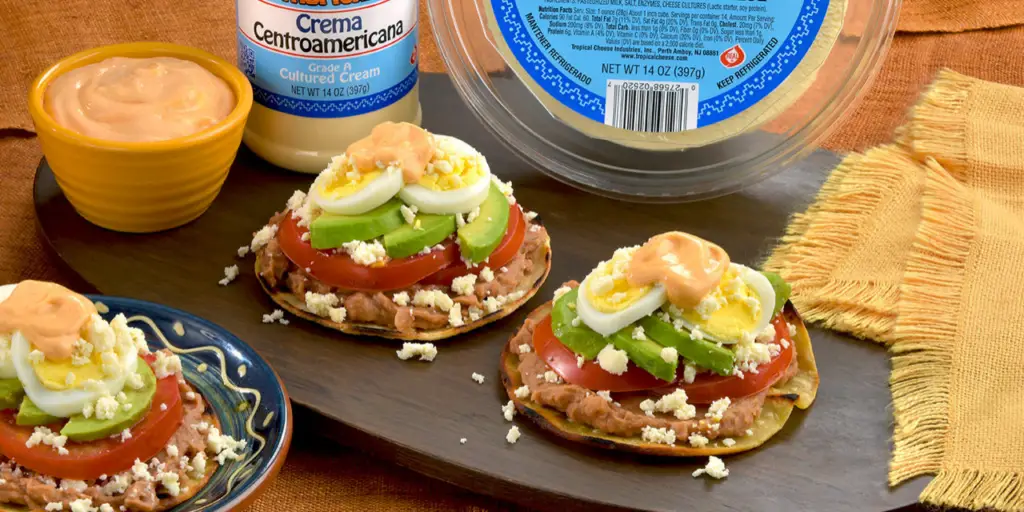
el Salvador cuisine – History and Background of Tamales de Pollo
Tamales de Pollo, a cherished dish in El Salvador, have deep historical roots, reflecting a fusion of indigenous, Spanish, and African culinary influences. Tamales, in general, have been a staple in Central American cuisine for centuries, with the art of tamale-making passed down through generations.
In El Salvador, Tamales de Pollo are often associated with celebrations, holidays, and special occasions, showcasing the country’s vibrant food culture and communal traditions.
el Salvador cuisine – Ingredients for Tamales de Pollo
For the Chicken Filling
- Chicken (boneless, cooked, and shredded)
- Onion (finely chopped)
- Bell pepper (finely chopped)
- Tomato (diced)
- Garlic (minced)
- Achiote paste or powder (for color and flavor)
- Cumin
- Salt and pepper
- Olive oil
- Chicken broth
Tamale Dough (Masa)
- Masa harina (corn flour)
- Chicken broth
- Lard or vegetable shortening
- Baking powder
- Salt
For Assembly
- Banana leaves (or corn husks), softened in warm water
- Red bell pepper strips (for tying tamales)
- Olives and capers (optional, for garnish)
el Salvador cuisine – Tamales de Pollo Recipe
Prepare the Chicken Filling
- Sauté onions, bell peppers, and garlic in olive oil until softened.
- Add diced tomatoes, shredded chicken, achiote paste or powder, cumin, salt, and pepper.
- Cook until well combined, adding chicken broth as needed for moisture.
- Allow the filling to cool.
Prepare the Tamale Dough
- In a large bowl, combine masa harina, chicken broth, melted lard or shortening, baking powder, and salt.
- Mix until you achieve a smooth, pliable consistency.
Assemble Tamales de Pollo
- Lay out softened banana leaves or corn husks.
- Spread a thin layer of tamale dough on each leaf.
- Add a spoonful of the chicken filling in the center.
- Fold the sides of the leaf over the filling, creating a rectangular packet.
- Tie the tamales with red bell pepper strips.
Steam Tamales
- tamales in a steamer vertically.
Serve
- Allow tamales to cool slightly before unwrapping.
- Garnish with olives and capers if desired.
- Serve warm and enjoy these flavorful Tamales de Pollo, a true delight in Salvadoran cuisine.
- Steam for approximately 1.5 to 2 hours or until the dough is cooked through.
Celebrate the richness of El Salvador’s culinary heritage with these delicious and festive Tamales de Pollo!
El Salvadoran cuisine – Sopa de res
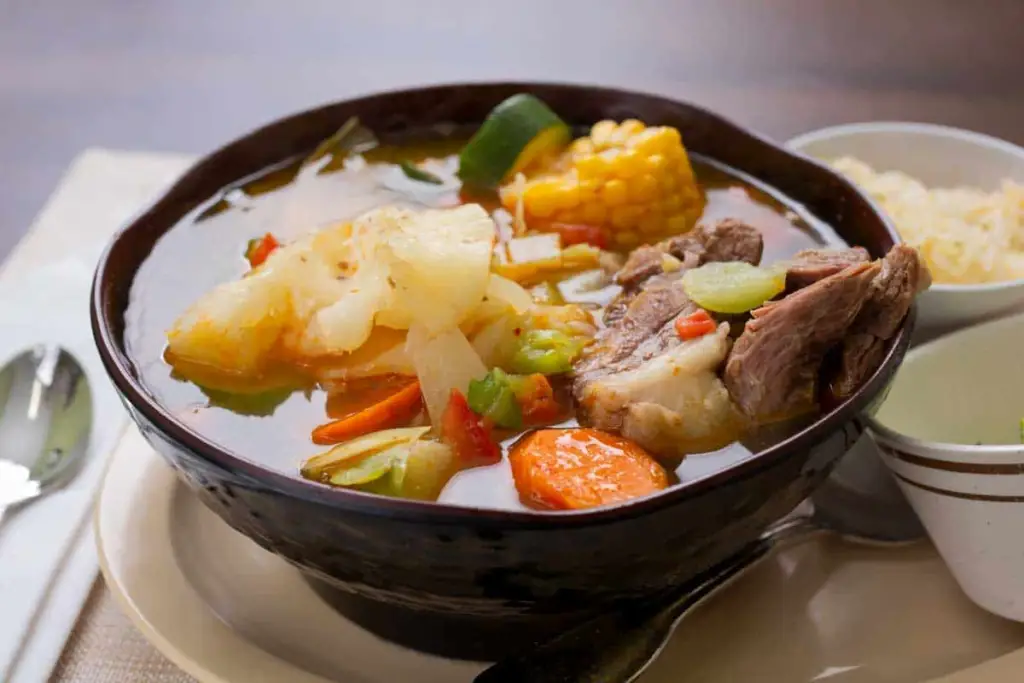
el Salvador cuisine – History and Background of Sopa de Res
Sopa de Res, a hearty beef soup, is a cherished dish in El Salvadorian cuisine. Its roots trace back to the country’s agricultural heritage and the influence of indigenous, Spanish, and African culinary traditions.
Often enjoyed as a comforting and nourishing meal, Sopa de Res reflects the warmth of Salvadorian hospitality. This soup has evolved over generations, becoming a symbol of communal gatherings and family celebrations, showcasing the diverse flavors of the region.
el Salvador cuisine – Ingredients for Sopa de Res
For the Broth
- Beef shank or beef stew meat
- Beef bones
- Water
- Onion, peeled and halved
- Carrots, peeled and chopped
- Celery, chopped
- Garlic cloves, minced
- Fresh cilantro
- Salt and pepper to taste
Soup
- Corn on the cob, cut into thirds
- Yuca (cassava), peeled and cut into chunks
- Plantains, peeled and sliced
- Potatoes, peeled and diced
- Chayote, peeled and diced
- Cabbage, shredded
- Green beans, trimmed and halved
- Corn kernels (fresh or frozen)
- Tomato sauce
- Beef bouillon or beef broth (optional, for extra flavor)
- Salt and pepper to taste
For Serving (optional)
- Lime wedges
- Fresh cilantro, chopped
- Hot sauce
el Salvador cuisine – Sopa de Res Recipe
Prepare the Broth
- In a large pot, combine beef shank, beef bones, water, onion, carrots, celery, garlic, cilantro, salt, and pepper.
- Bring to a boil, then reduce heat and simmer for at least 1.5 to 2 hours, skimming any impurities that rise to the surface.
- Strain the broth and set aside.
Prepare the Soup
- Return the strained broth to the pot.
- Add corn on the cob, yuca, plantains, potatoes, chayote, cabbage, green beans, and corn kernels.
- Stir in tomato sauce and beef bouillon if using.
- Simmer until all the vegetables are tender, usually 30-40 minutes.
- Adjust seasoning with salt and pepper.
Serve
- Ladle the soup into bowls, ensuring a variety of vegetables and meat in each serving.
- Garnish with fresh cilantro and lime wedges if desired.
- Serve hot with optional hot sauce on the side.
Enjoy the robust flavors and nourishing warmth of Sopa de Res, a beloved and comforting dish in El Salvadorian cuisine.
El Salvadoran cuisine – Arroz con leche
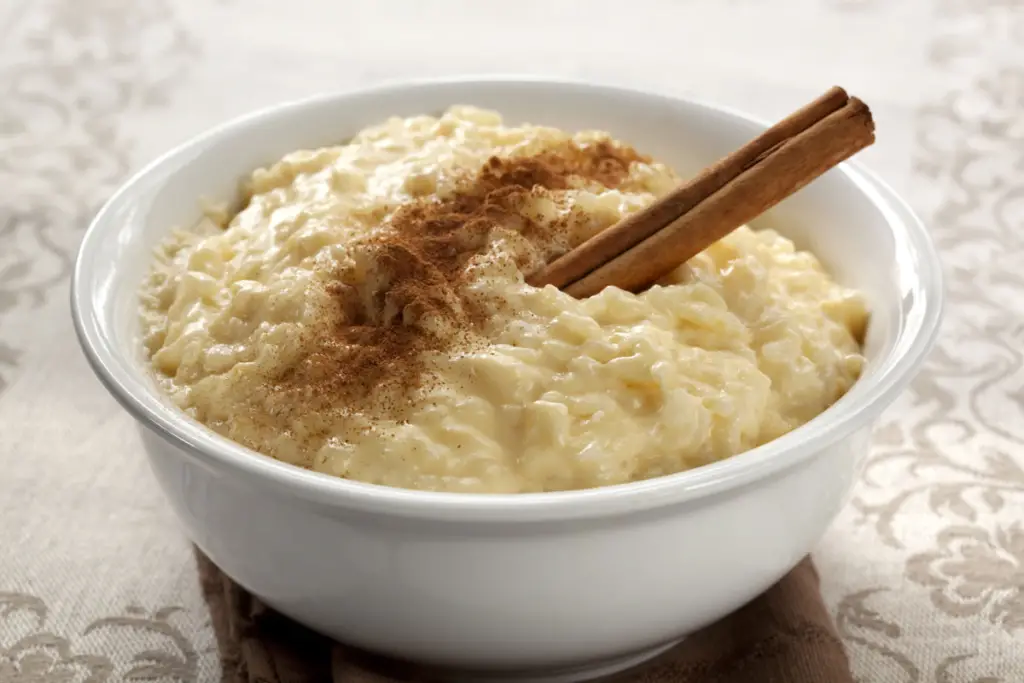
el Salvador cuisine – History and Background of Arroz con Leche
Arroz con Leche, or rice pudding, is a classic and beloved dessert in El Salvadorian cuisine. This sweet treat has deep roots in the country’s culinary heritage, influenced by Spanish traditions and enriched with local ingredients.
Arroz con Leche is a symbol of comfort, often enjoyed during festive occasions, family gatherings, and celebrations. The simplicity of its ingredients and the richness of its flavor make it a timeless and cherished dessert in El Salvador.
el Salvador cuisine – Ingredients for Arroz con Leche
Rice Pudding
- 1 cup white rice
- 4 cups whole milk
- 1 cinnamon stick
- 1 cup sugar (adjust to taste)
- 1/2 teaspoon salt
- 1 teaspoon vanilla extract
- Ground cinnamon for garnish
Optional Additions
- Lemon or orange zest for added flavor
- Raisins or dried fruit
- Condensed milk for extra sweetness
- Nutmeg for a hint of spice
el Salvador cuisine – Arroz con Leche Recipe
Rinse the Rice
- Rinse the white rice under cold water until the water runs clear.
Cook the Rice
- In a medium-sized pot, combine the rinsed rice, whole milk, and a cinnamon stick.
- Bring to a boil, then reduce heat to low and simmer. Stir occasionally to prevent sticking.
Sweeten and Flavor
- Once the rice is almost fully cooked and the mixture has thickened, add sugar, salt, and vanilla extract.
- Continue to simmer until the rice is tender, and the pudding reaches a creamy consistency.
Optional Additions
- If desired, add lemon or orange zest, raisins, or dried fruit for extra flavor.
- Adjust sweetness by adding condensed milk to taste.
Serve
- Remove the cinnamon stick.
- Spoon the Arroz con Leche into serving bowls or a large dish.
Chill and Garnish
- Allow the rice pudding to cool to room temperature before refrigerating.
- Once chilled, sprinkle ground cinnamon on top before serving.
Enjoy
- Serve chilled and savor the creamy, comforting goodness of El Salvador’s Arroz con Leche.
Whether enjoyed as a simple family dessert or part of a festive feast, Arroz con Leche embodies the sweet essence of El Salvadorian culinary traditions.
Taste the Unique Twists of El Salvador Cuisine – Chicharrón con yuca

el Salvador cuisine – History and Background of Chicharrón con Yuca
Chicharrón con Yuca is a popular and flavorful dish in El Salvadorian cuisine, showcasing a delightful combination of crispy pork belly (chicharrón) and tender yuca (cassava).
This dish is a culinary celebration of the country’s agricultural abundance and the art of transforming simple ingredients into a savory delight. Chicharrón con Yuca is often enjoyed as a hearty snack or as part of a festive meal, reflecting the rich tapestry of flavors found in El Salvador.
el Salvador cuisine – Ingredients for Chicharrón con Yuca
For the Chicharrón
- Pork belly, skin-on, cut into chunks
- Salt
- Garlic powder
- Ground cumin
- Oregano
- Vinegar or bitter orange juice (for marinade)
- Water (for boiling)
For the Yuca
- Yuca (cassava), peeled and cut into chunks
- Salt
Frying
- Vegetable oil
Optional Sides
- Curtido (fermented cabbage slaw)
- Salsa roja (red salsa)
el Salvador cuisine – Chicharrón con Yuca Recipe
Prepare the Chicharrón
- In a large bowl, marinate the pork belly chunks with salt, garlic powder, ground cumin, oregano, vinegar, and water.
- Allow it to marinate for at least 2-3 hours or overnight for richer flavor.
- Transfer the marinated pork belly to a pot, add water to cover, and bring to a boil.
- Reduce heat and simmer until the pork is tender and the skin can be easily pierced with a fork.
- Remove the pork from the water and allow it to air-dry or pat it dry with paper towels.
- Heat vegetable oil in a deep pan or fryer. Fry the pork until the skin is crispy and golden brown.
Prepare the Yuca
- Peel the yuca and cut it into chunks.
- Boil the yuca in salted water until it is tender.
- Drain and set aside.
Fry the Yuca
- Heat oil in a separate pan for frying yuca.
- Fry the boiled yuca until it develops a golden crust.
Serve
- Arrange the crispy Chicharrón and fried yuca on a serving platter.
- Optionally, serve with curtido and salsa roja on the side for added flavor.
Enjoy
- Chicharrón con Yuca is best enjoyed hot and crispy. Dip the yuca in salsa or pair it with the tangy curtido for a delightful taste of El Salvador.
Experience the savory goodness of Chicharrón con Yuca, a dish that captures the essence of El Salvadorian culinary excellence.
Conclusion
El Salvador cuisine is a treasure trove of authentic Central American flavors, and we hope that our journey through its dishes has left you feeling inspired to try them for yourself.
Whether you are enjoying a pupusa with friends or indulging in a plate of carne asada, we encourage you to savor the unique flavors and aromas of Salvadoran cuisine.
FAQ’s
What is El Salvador cuisine?
El Salvador cuisine refers to the traditional dishes and culinary practices of the country. It is characterized by its use of fresh ingredients, bold flavors, and a combination of indigenous and Spanish influences.
Define El Salvador Food Culture
El Salvador’s food culture is rich and diverse, reflecting its history and blending indigenous, Spanish, and African influences. Traditional Salvadoran dishes include pupusas, a corn tortilla filled with cheese, beans, or meat, and yuca con chicharrón, a dish made with fried pork rinds and cassava.
These delicious culinary traditions are deeply rooted in the country’s cultural identity.
What is Popular Food In El Salvador?
Pupusas are the most popular food in El Salvador. These thick, handmade corn tortillas are typically filled with cheese, beans, or meat, and served with curtido (fermented cabbage slaw) and salsa. Pupusas are a beloved national dish and can be found in every corner of the country.
What is El Salvador Culture Food?
El Salvador culture food is rich in traditions. Pupusas, a popular dish made of corn tortillas stuffed with cheese, beans, or meat, are a must-try. Other traditional foods include yuca con chicharrón (cassava with fried pork), tamales, and atol de elote (sweet corn beverage).
El Salvador’s cuisine reflects its indigenous roots and Spanish influences.
What is El Salvador Traditional Food?
El Salvador Traditional Food offers a variety of recipes that showcase its rich culinary heritage. Pupusas, a popular dish made of thick corn tortillas filled with cheese, meat, or beans, are a must-try.
Other delicious options include yuca con chicharrón (fried cassava with pork), tamales, and sopa de pata (cow’s feet soup). These dishes exemplify the diverse and flavorful cuisine of El Salvador.
What is the National Food Of El Salvador?
Pupusa is considered the national food of El Salvador. This traditional dish consists of thick tortillas made from cornmeal or rice flour, filled with various ingredients like cheese, beans, or meat. Pupusas are often served with curtido, a tangy cabbage slaw, and salsa. They reflect the rich culinary heritage of El Salvador.
What is El Salvador Famous Food?
El Salvador is famous for its traditional cuisine, which includes a variety of flavorful dishes. Pupusas, a type of stuffed tortilla, are a popular and iconic food in El Salvador.
They are typically filled with cheese, beans, or meats and served with pickled cabbage and salsa. Pupusas are enjoyed by locals and visitors alike, showcasing the rich flavors of El Salvador.
What are the characteristics of Authentic El Salvador Food?
Authentic El Salvador food offers a rich culinary experience with its diverse flavors. Traditional dishes like pupusas, yuca frita, and tamales showcase the country’s cultural heritage. These dishes often incorporate ingredients like corn, beans, and cheese, resulting in a delicious blend of savory flavors that reflect El Salvador’s unique cuisine.
What are Central American Dishes?
Central American dishes are known for their vibrant flavors and rich culinary traditions. From the savory pupusas of El Salvador to the hearty gallo pinto of Costa Rica, these dishes highlight the region’s diverse ingredients and cultural influences.
Whether it’s the spicy chiles rellenos of Guatemala or the refreshing ceviche of Belize, Central American cuisine offers a taste of the region’s unique and delicious flavors.

